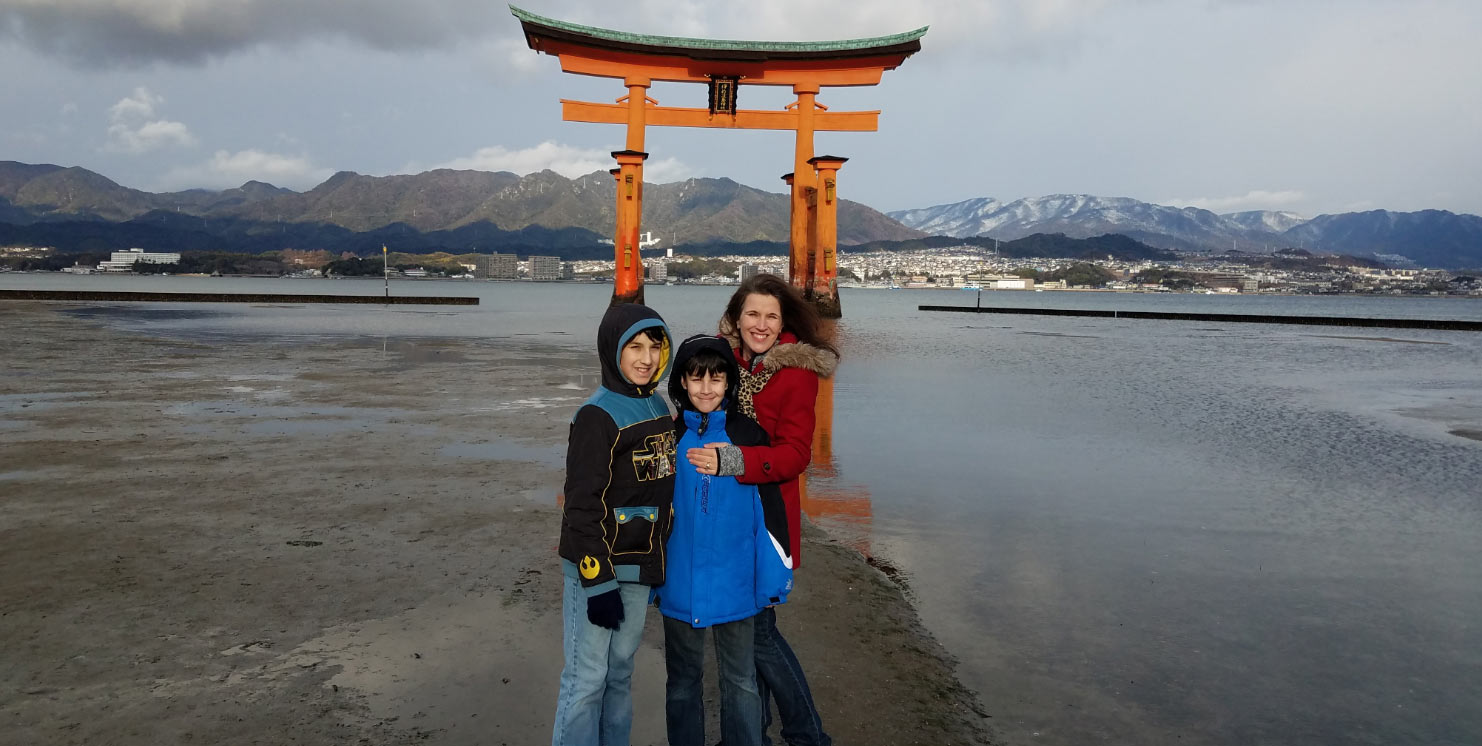
Earlier this year, our family spent ten days in Japan. That, alone, was a dream come true for us — we have always wanted to visit Japan, and the experiences we had visiting Osaka, Hiroshima, Miyajima, Nagano, and Tokyo have left indelible imprints on our lives. The beauty of this marvelous country, the kindness of its people, and the richness of the Japanese culture are things we’ll never forget.
Near the end of our trip, we also spent a couple of days at Tokyo Disneyland and DisneySea. As a Disney lover, this was the perfect end to an already-magical trip! We have been to Walt Disney World and Disneyland many times, but I always, always dreamed of visiting Disney in Tokyo. This year, that dream became a reality.
Jump to:
- Tokyo has two Disney Parks: Tokyo Disneyland and DisneySea
- Attractions you won’t want to miss
- The ride queues in both parks are breathtaking!
- You’ll have no problem seeing parades or fireworks shows
- Try the popcorn. Really, try the popcorn. It’s a major thing here.
- “Language barrier?” What language barrier?
- Souvenir shopping is memorable… and interesting!
- Dining in the parks is amazing — and often a bargain.
- Visiting the Tokyo Disney parks may cost less than a trip to Walt Disney World!
- But… you’ll pay to ride the monorail!
- Last thoughts…
Or, read on!
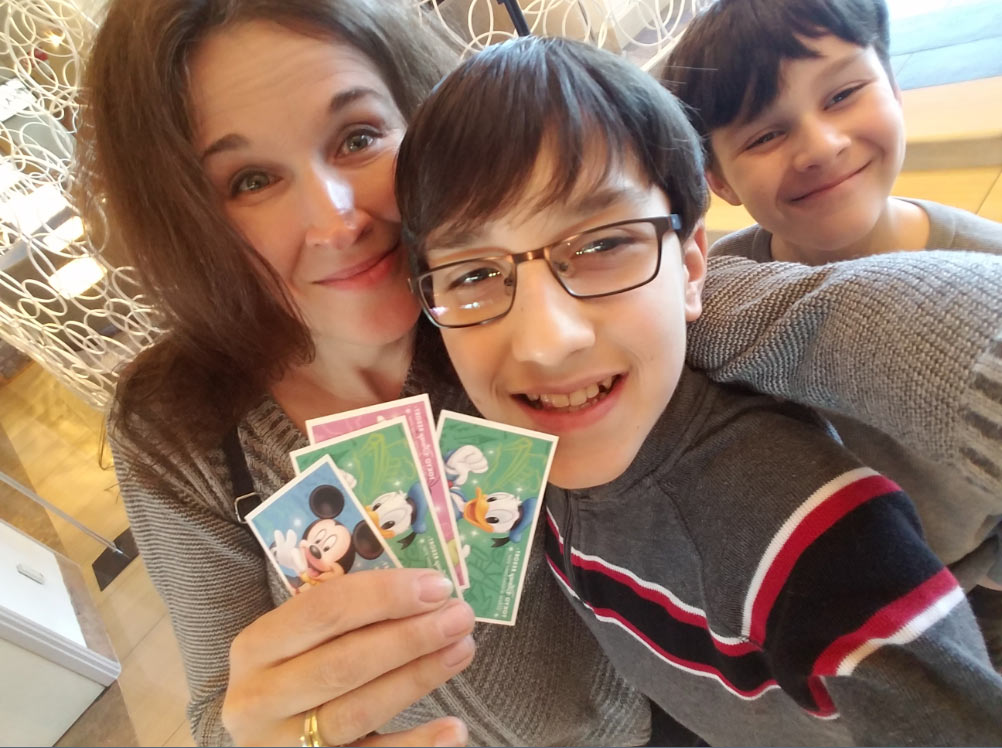
Tokyo Disneyland celebrates its 35th anniversary this year, and visiting both Tokyo Disney parks was truly an “I can’t believe we’re here!” moment for me. As I held our park tickets in my hand, I couldn’t hold back the happy tears that filled my eyes. Minutes later, we boarded the monorail and began our Japanese Disney adventure!

Tokyo has two Disney Parks: Tokyo Disneyland and DisneySea
If you’re familiar with the original Disneyland park in Anaheim, or the Magic Kingdom at Walt Disney World, you’ll feel right at home in Tokyo Disneyland. The park is laid out in a similar fashion to these other classic parks, but with a few differences. As you’re not in the United States, “Main Street USA” is not part of Tokyo Disneyland! Instead, you’ll step into World Bazaar.

Tokyo Disneyland’s World Bazaar is covered by an intricate glass and steel canopy that spans multiple blocks. As Japan experiences all four seasons of weather, the canopy keeps both rain and snow off of guests as they shop and dine.
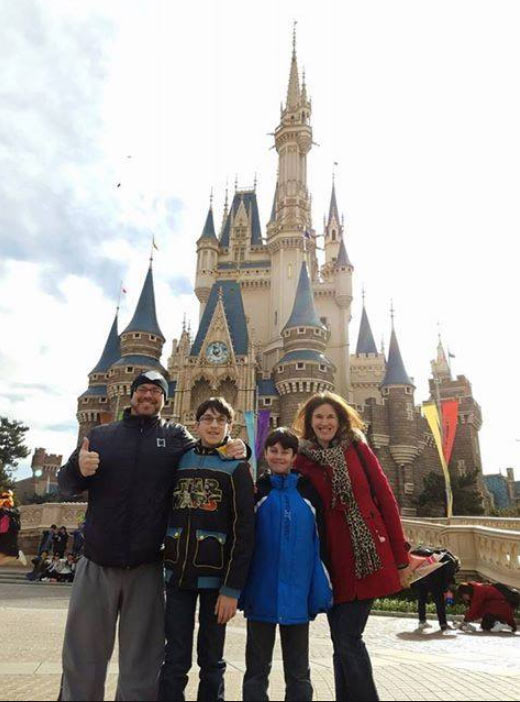
It wouldn’t be a Disney park without a castle, would it? Each Disney castle is unique. Tokyo Disneyland’s castle is smaller than the one in Walt Disney World, but it’s just as gorgeously constructed and is breathtaking to see in person.

You’ve probably already noticed too that we’re bundled up! This was our first experience visiting a theme park during winter weather. We learned that winter is actually a great time to go to the Tokyo Disney parks, as the crowds are at their lowest. Winter in Japan isn’t as severe or cold as it is in the US, and you’ll get to see some fun things that you’ve never seen before if you’ve only visited the US parks, like…
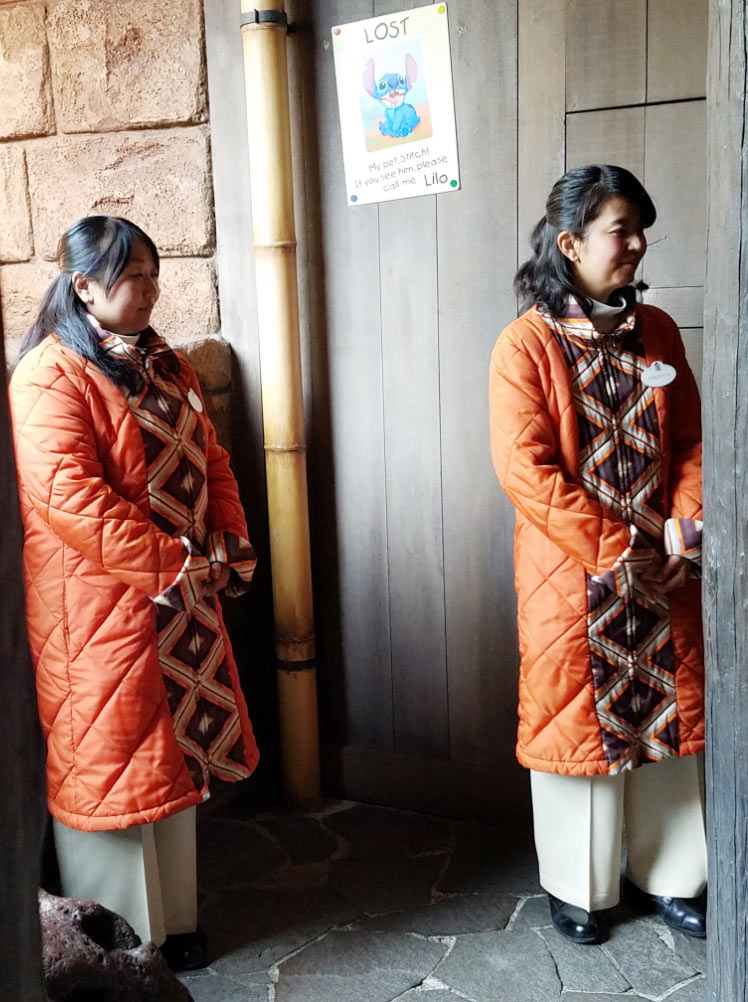
Enchanted Tiki Room cast members dressed in Hawaiian-themed long winter coats! As I am obsessed with the Enchanted Tiki Room in general (at all parks) I seriously would have bought one of these coats if I had found it in the gift shop. Alas, they were not for sale, but look at some of the other things the gift shop sold:
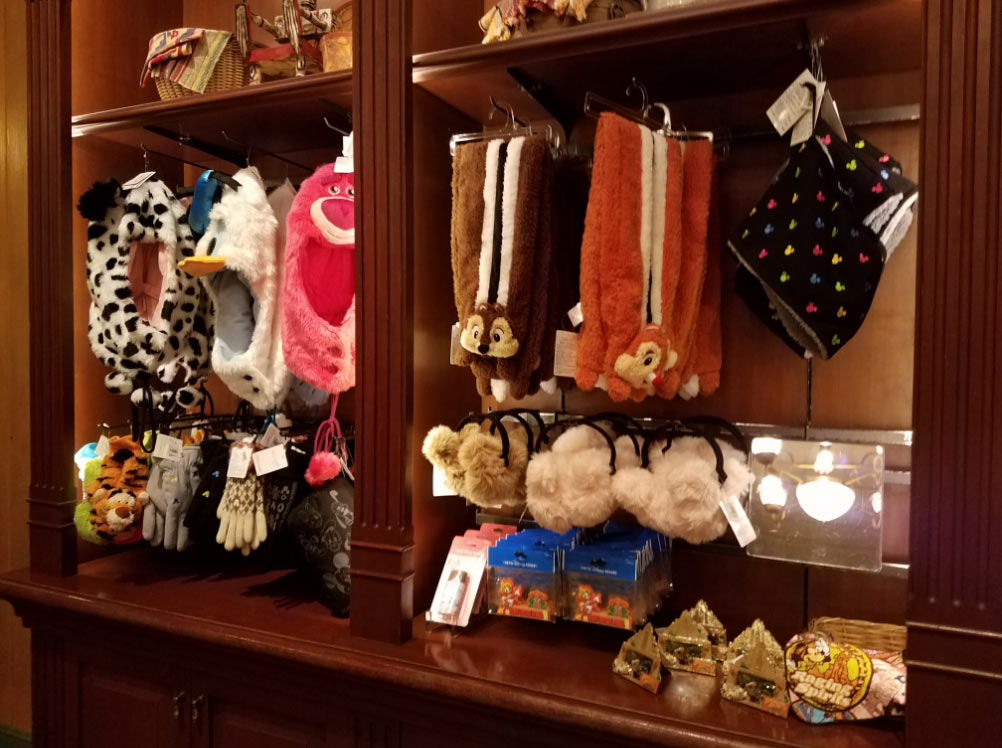
Winter hats, gloves, scarves, and earmuffs. (You probably won’t see these in Florida or California!) Another cold-weather item seemed to be extremely popular with park-goers in Japan too:
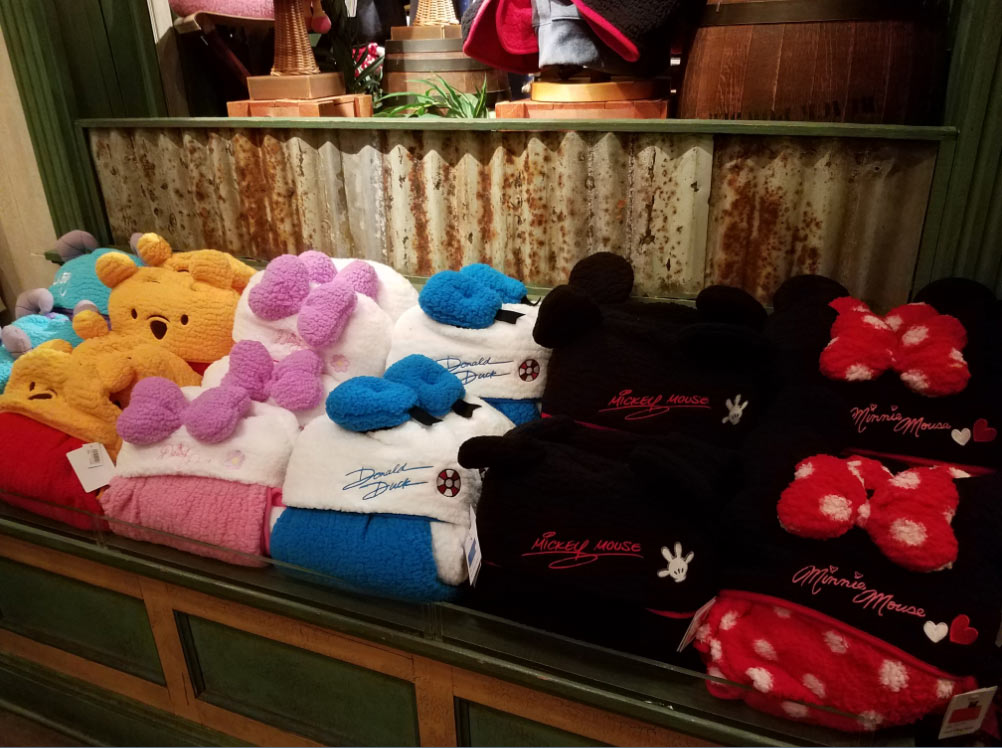
These wearable fleece blankets each have a hood with the face, hat, or ears of a Disney character on top. Many guests were wearing them around the park, snuggled up as they walked around in the colors of their favorite Disney characters. In fact, I’ll share a little more about the gift shop selection later in this post, but the idea of escapism is very popular in the Japanese Disney parks. Adults and children alike are dressing in brightly-colored Disney gear that you might assume would be geared more toward younger guests. In Japan, everyone is free to immerse themselves fully in Disney character-ism. It’s so much fun to see!
Attractions you won’t want to miss…
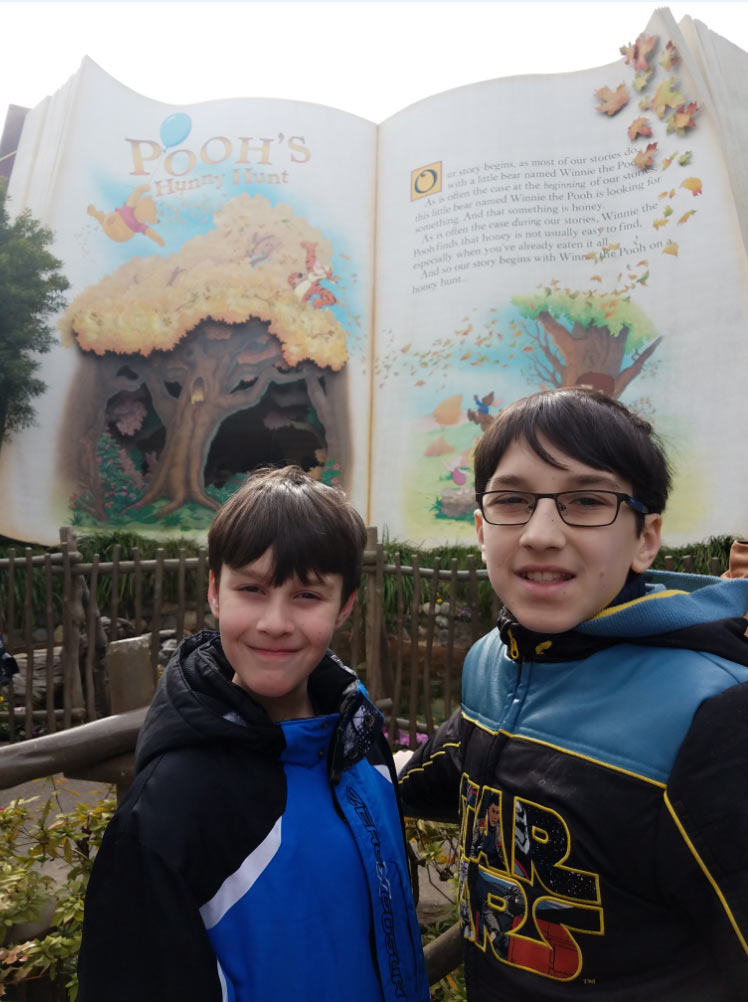
While many of the rides at Tokyo Disneyland have similar counterparts in the other parks (Space Mountain, Jungle Cruise, Pirates of the Caribbean) there are also rides unique to Tokyo. One of those rides is Pooh’s Hunny Hunt. While at first glance you might think this ride would not appeal to my middle-schoolers, I insisted we go, because I was pretty sure they’d love it. It is the most popular attraction in Tokyo Disneyland’s Fantasyland area of the park!
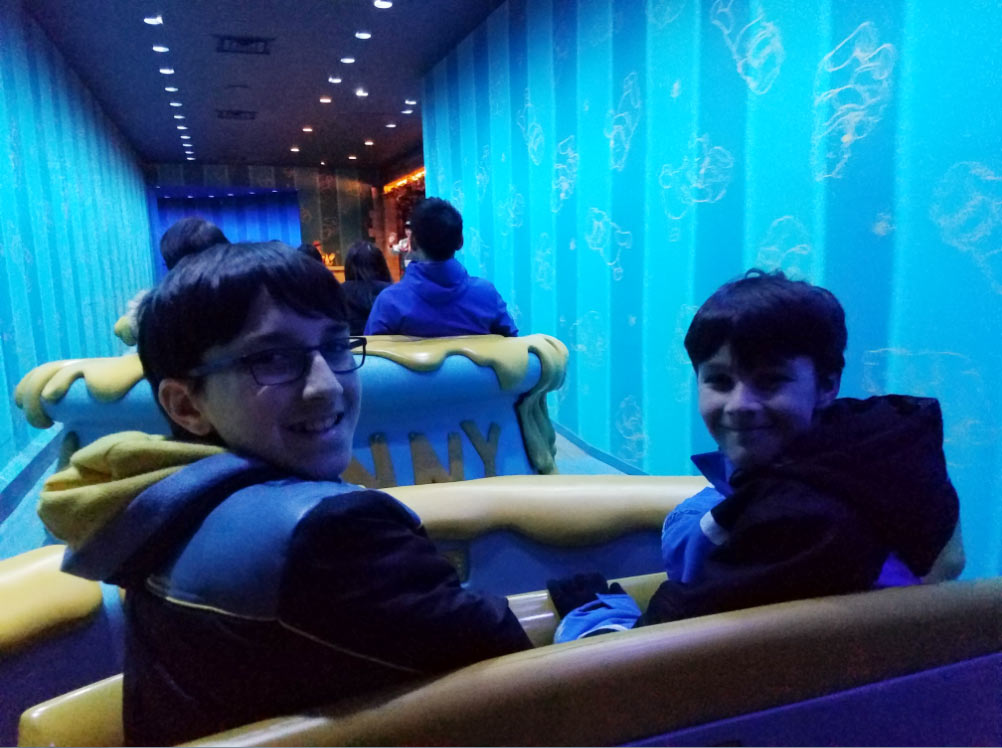
Pooh’s Hunny Hunt is a trackless ride. You board one of Pooh’s hunny pots, and then you’re off on a wild, psychadelic and colorful dark ride adventure. However, your hunny pot is fully controlled by an LPS system. There is no track on the floor or ceiling, so you have no idea where your pot will go next — and looking at all of the other guests’ pots around you is no help either, as everyone’s pots are swirling and dancing around in an organized-chaos, almost-hitting-each-other but near-miss whirlwind of activity. The pots’ positioning is completely random, ride after ride, and it is a technological marvel that will hit all of the emotions of the child in you, leaving you thinking “Wow! What did we just ride?”
Then, we thought, “Why doesn’t Walt Disney World have anything quite like this? It must be new technology.” Nope — Pooh’s Hunny Hunt opened in 2000 and is using now-19-year-old tech! It’s simply marvelous.
(Luigi’s Rollickin’ Roadsters at Disney’s California Adventure and the Ratatouille ride at Disneyland Paris also use the same LPS trackless ride technology, although both of these rides have been built within the last four years. EPCOT is scheduled to get a similar Ratatouille ride in 2021.)
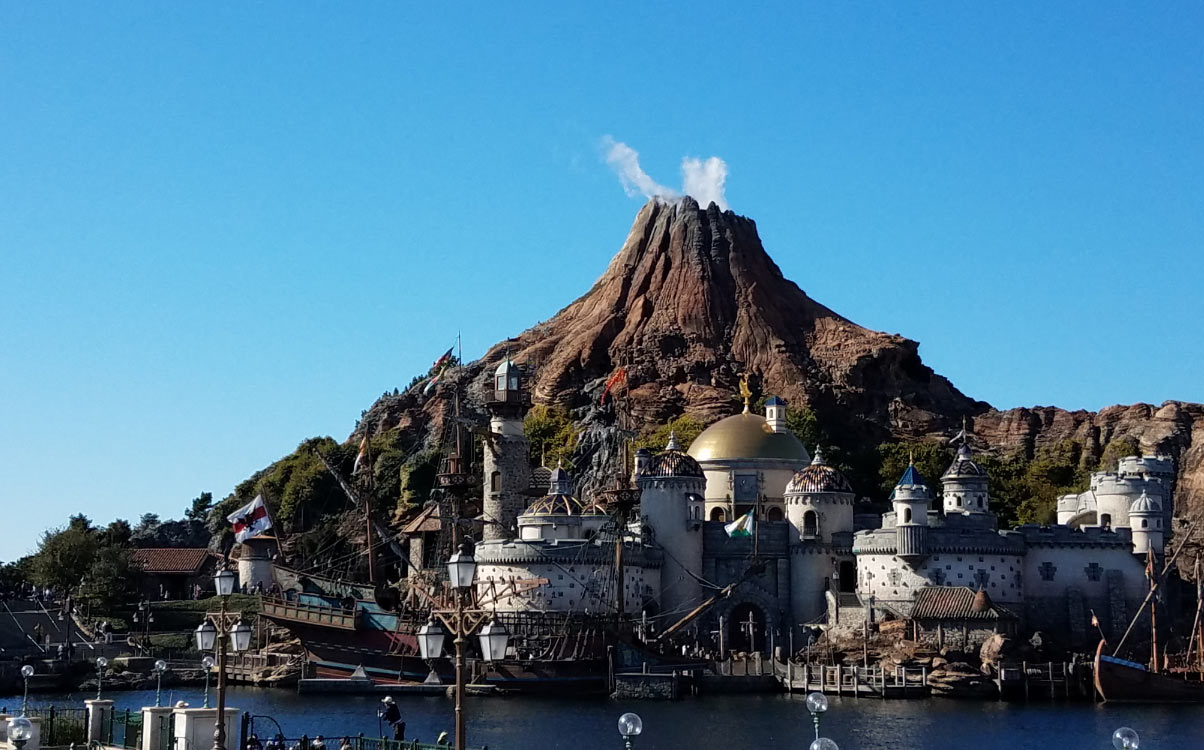
Tokyo DisneySea was the true highlight of the trip for me. I remember the first time I visited Walt Disney World and Disneyland respectively with my parents when I was young. However, walking through the gates of DisneySea, as an adult, was thrilling on multiple levels. First, DisneySea is a park unique to Tokyo — it does not exist in any of the other Disney parks around the world. The best way to describe it is Japan’s version of Epcot Center… if Epcot were situated on the water and every “country” was actually a coastline that faced a large body of water.
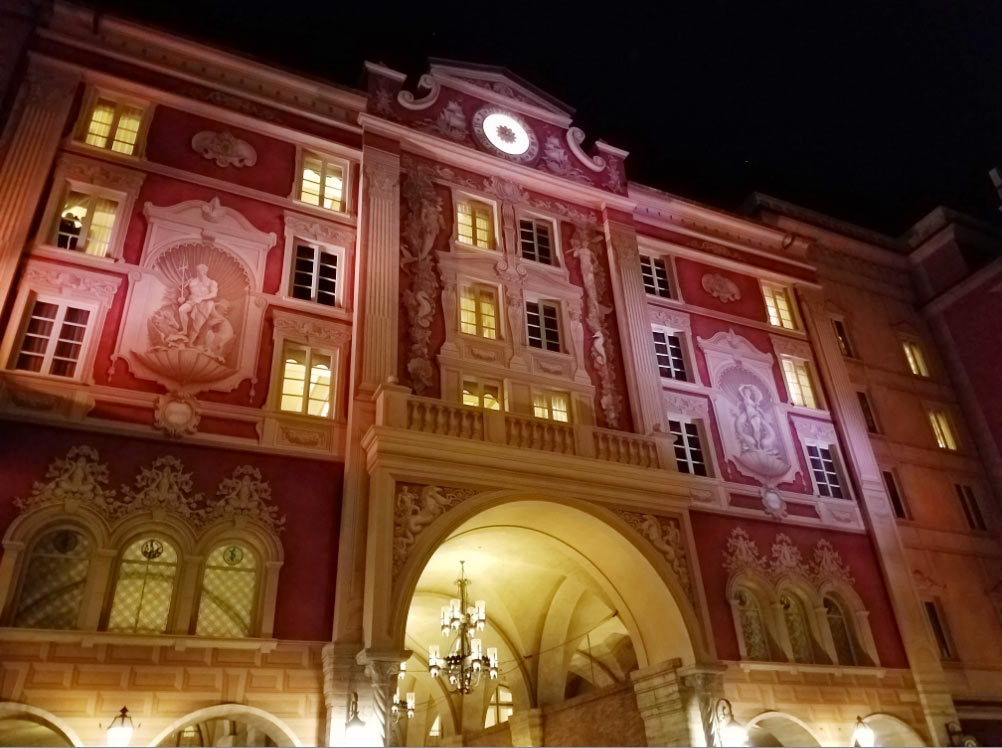
The intricacy of the architecture, theming, detail, and immersion in different lands and cultures is simply unlike anything at any other Disney park I’ve visited. I love them all, but DisneySea is simply Disney on a higher level of perfection (if that’s possible!) You get the impression that no expense was spared to create a living, immersive world for guests to fully experience.
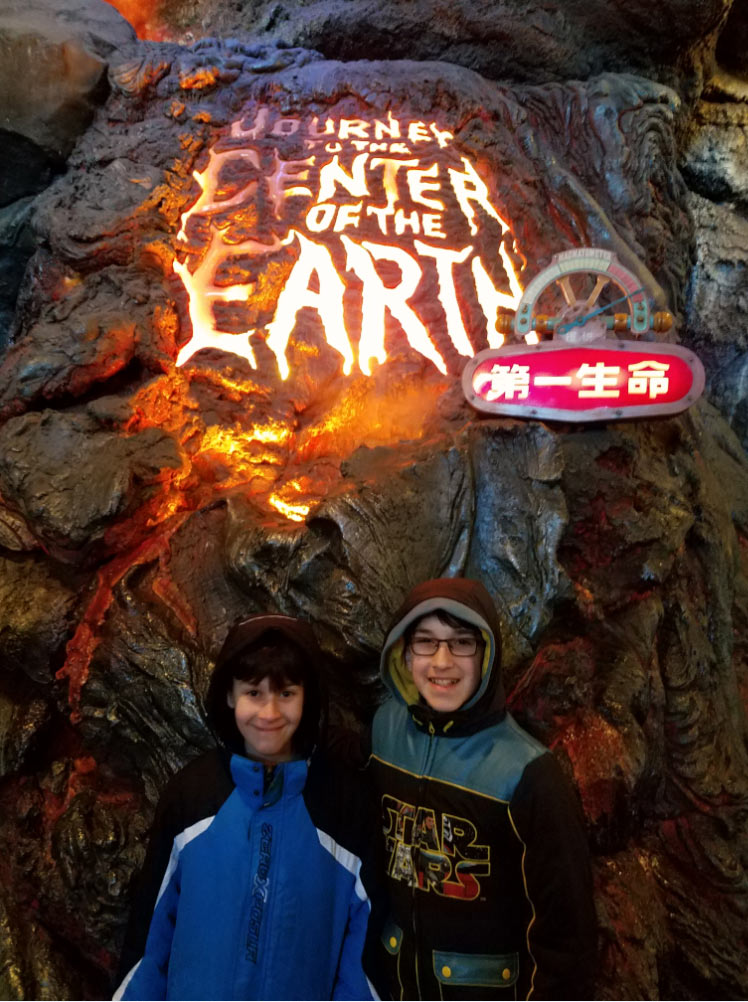
DisneySea also has rides and attractions that are exclusive to the park. Our favorite was Journey to the Center of the Earth. The ride is not based on the 2008 movie but rather the classic Jules Verne book! It uses similar technology to the Test Track and Radiator Springs Racers cars in the US parks, but it’s a multisensory experience on many more levels.
Riders begin underground after taking a “Terravator” a half-mile down into the earth. You board a steam-powered mining car and travel through many caverns of gems and jewels before encountering an enormous, horrible beast that lives deep in the Earth. This is when the ride really kicks in, and it becomes a wild, fast, twisty coaster that ejects you back up to the Earth’s surface, out into the open air in the Mysterious Island land of the park, then back down into darkness to finish the ride deep in the Earth once more. It’s easily the most thrilling ride we’ve ever experienced in a Disney park!
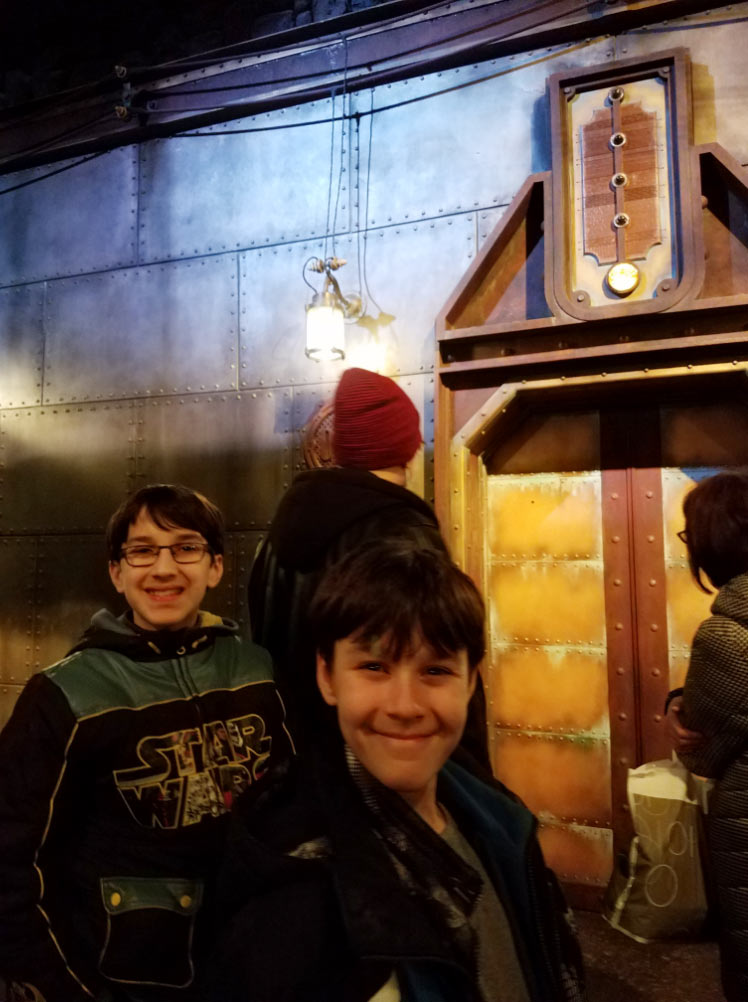
The ride queues in both parks are breathtaking!
Disney has always done a wonderful job of creating entertaining environments for you to look at while waiting in line, but some of the queue areas at Tokyo DisneySea are beyond beautiful. The level of detail created by setting the stage with props and artifacts simply could not be equaled in the US, largely because there is a highly prevalent, shared cultural belief in Japan that public areas are for everyone’s enjoyment and should be preserved.
There are so many items within touching distance of the queue lines, but no one disturbs the displays, attempts to take or break off a souvenir, or leave a graffiti mark. Because of this, you’re treated to some truly spectacular queue displays while you wait. Check out these photos from inside Journey to the Center of the Earth — and keep in mind that anyone could have touched any one of these things, but no one does:
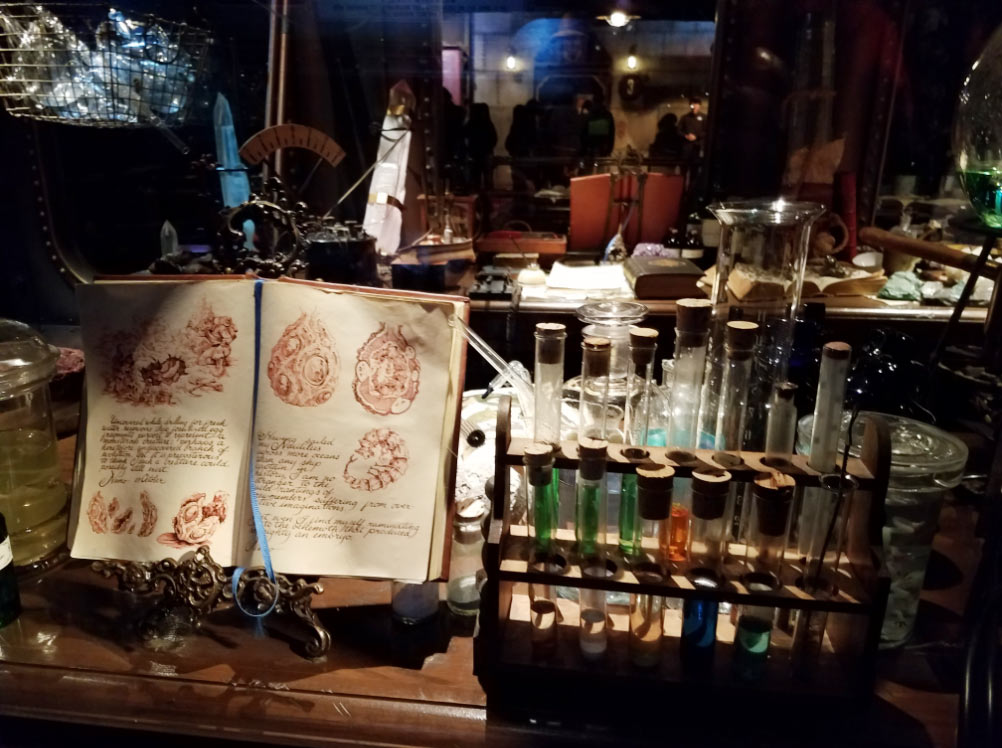

The queue area at DisneySea’s Tower of Terror is outstanding as well. In the US parks, there are velvet ropes to keep you away from many of the items in the haunted hotel’s lobby area. In Tokyo, the queue lines up right along the hotel’s check-in desk. so your body is already standing or leaning on the desk’s wall as you wait.
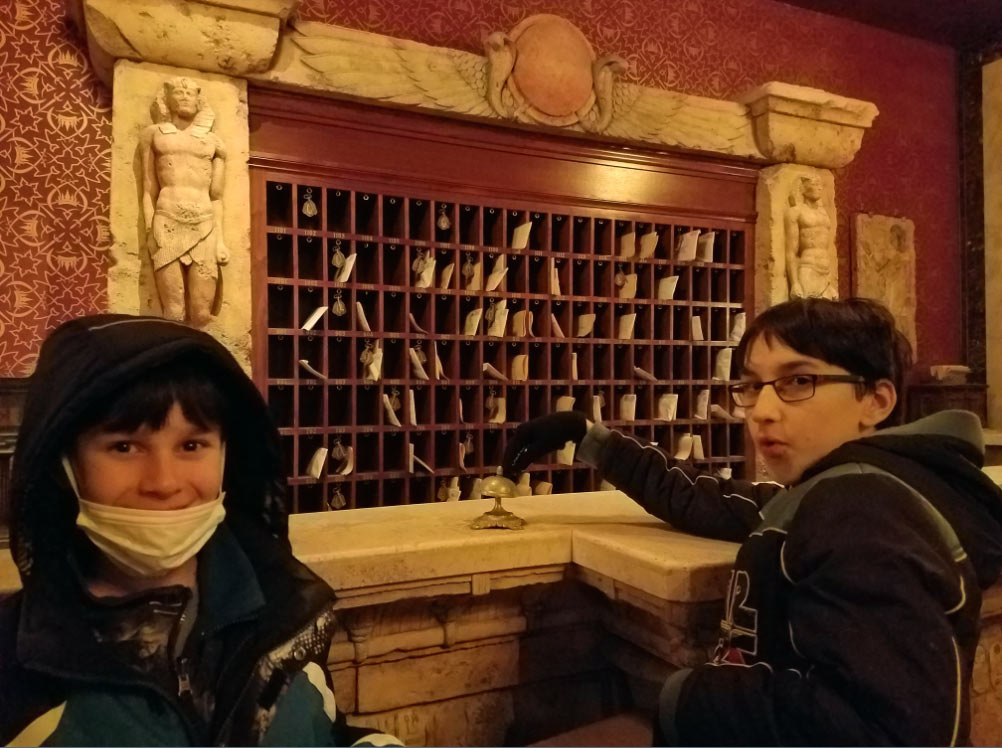
Now, this photo got us in a bit of trouble! While we waited for the ride, I told my son to pretend to ring the check-in bell at the desk. To pretend. Remember, this is the actual line for the ride — we weren’t standing in an area where we weren’t supposed to be. My son did not touch the bell. He posed. I took this photo. Then, numerous other Japanese guests waiting in line immediately said “No touch! No touch!” to our family.
Oops. It was the first time on the entire trip that I felt we’d been “dumb Americans.” We knew not to touch, but even pretending to touch created a cultural faux-pas.
(If you’re wondering why my little guy is wearing a mask, it’s because he came down with a cold the night before. Coughing, sneezing, or having a runny nose in public are also major cultural no-nos in Japan, and you’re obligated to protect the people around you by wearing a mask.)

While we’re on the topic of Japan’s Tower of Terror, I have to share how much we enjoyed it! Unlike its US counterparts, the ride is not based around The Twilight Zone, as that television show is largely unknown to the Japanese people. DisneySea’s Tower of Terror is located in the New York City area of the park’s American Waterfront. The tower itself is wildly different in architectural style and size compared to the US parks’ towers too.
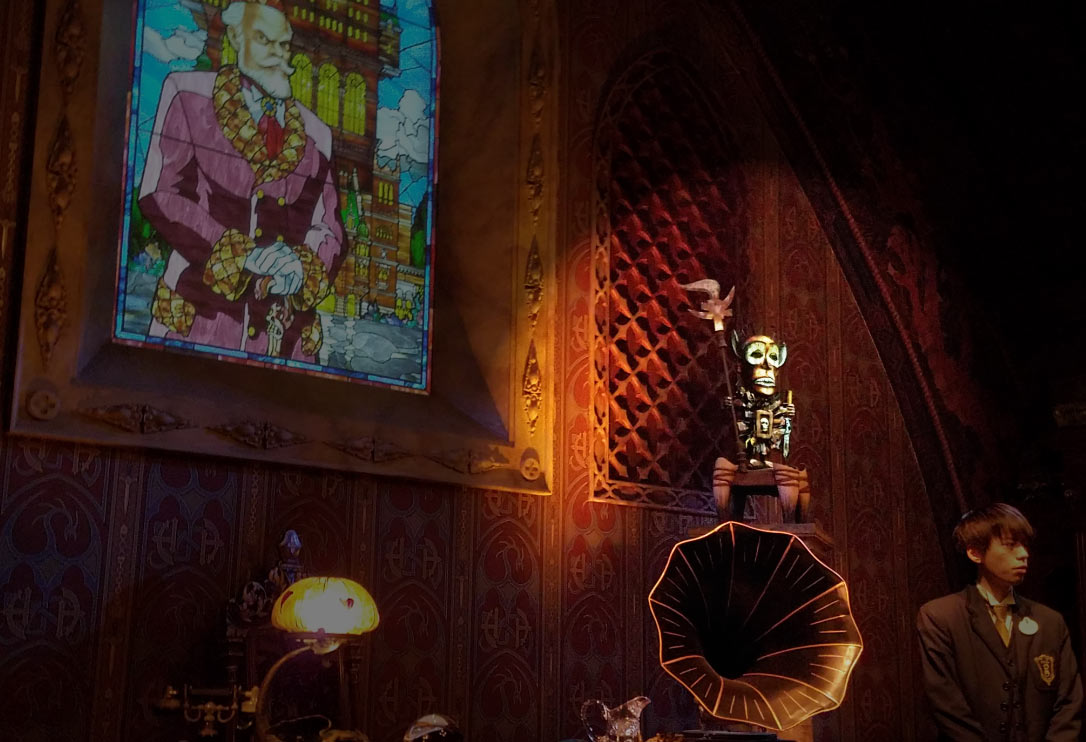
The story goes that the tower was built by a wealthy American explorer, Harrison Hightower. On one of his archaeological trips, Hightower brought back a haunted tiki-like idol called the Shiriki Utundu. After bringing the idol home, it haunted the house, Hightower mysteriously disappeared in one of the tower’s elevators… and you may too!
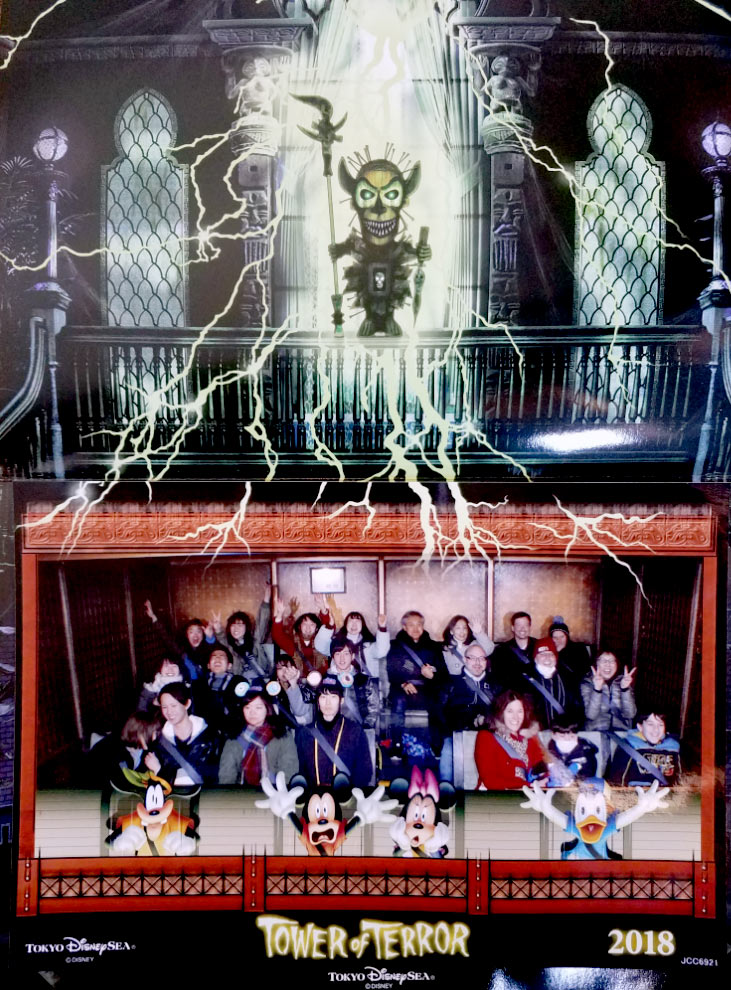
You’ll have no problem seeing parades or fireworks shows.
Just like other Disney parks, Tokyo Disneyland and DisneySea have multiple parades and stage shows throughout the day, as well as fireworks at night. However, you’ll have no issues with your kids being able to see all of the action. This was just one of many amazing cultural differences between the Japanese people versus what we experience in the United States. When it’s time for a parade, show, or fireworks, this is what you’ll see all along the viewing route:

Everyone sits down on the ground. Everyone! Many people bring small stools or cloths (called “leisure sheets”) to place on the ground and sit down on. It’s very orderly, and it is not something Disney instructs people to do — again, it is simply part of their culture to make sure everyone is able to enjoy a shared experience. Tokyo Disney’s fireworks shows are shorter and not as elaborate as they are in the US parks, but they are still quite dazzling and a wonderful way to wind down your night.
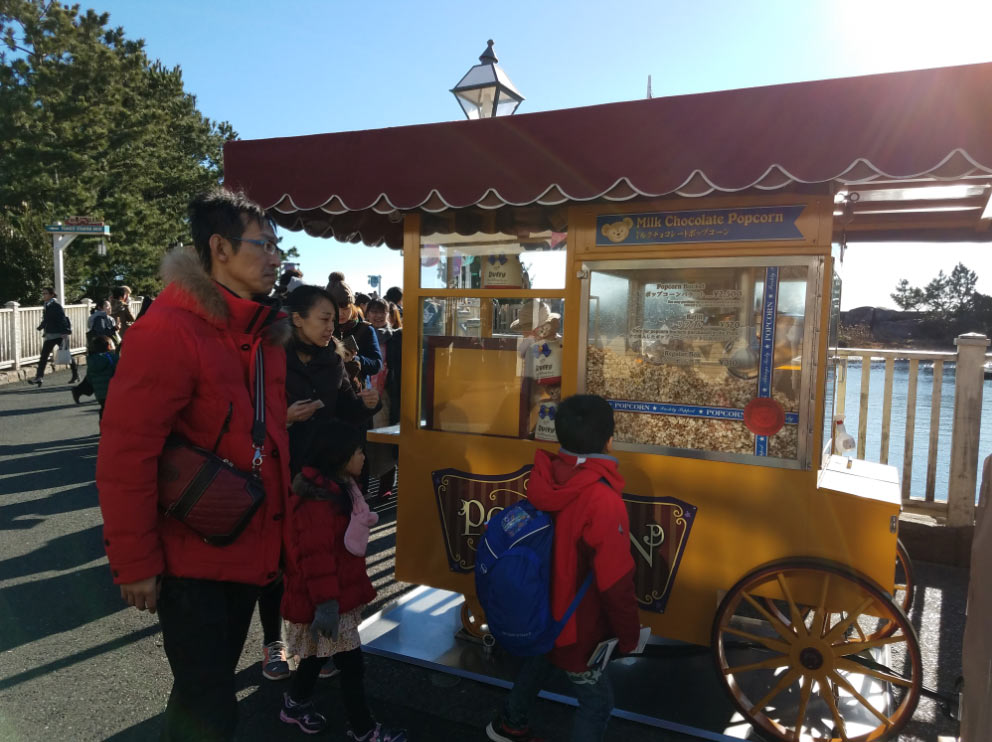
Try the popcorn. Really, try the popcorn. It’s a major thing here.
All over both parks, you’ll see popcorn carts with the most fanciful flavors of popcorn: Honey. Milk chocolate. Butter Soy Sauce. You’ll also see lines rivaling those for a children’s ride — but it’s people lining up to buy popcorn! The flavored popcorn available at Tokyo Disneyland and DisneySea is a major phenomenon, and you’ll be missing out if you don’t sample at least one flavor.
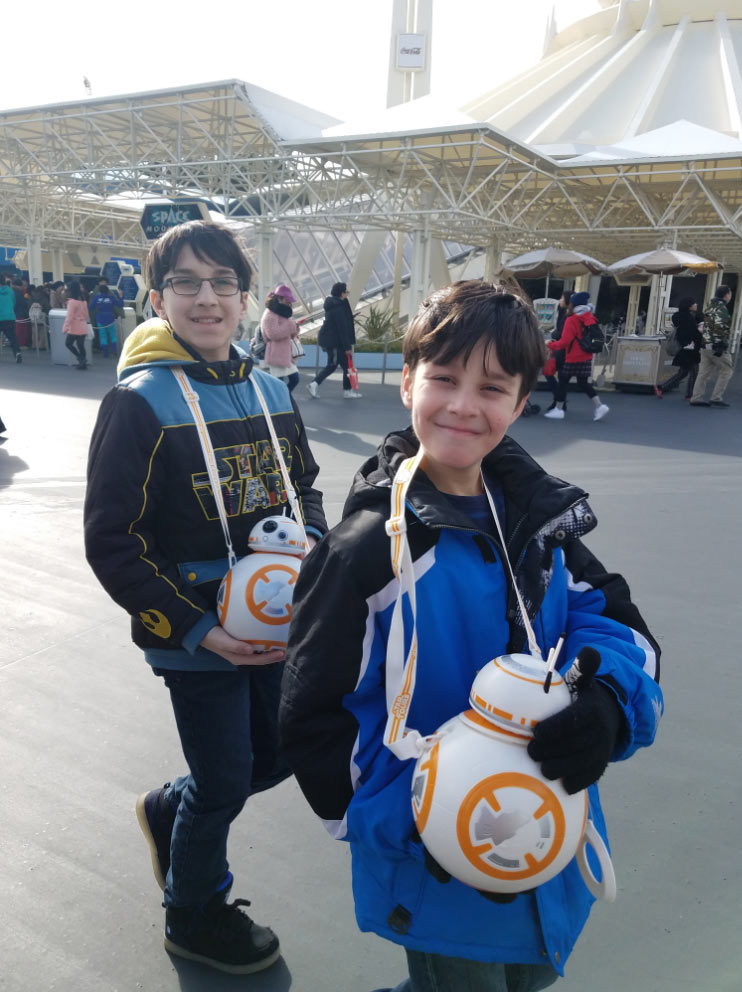
You can purchase a cardboard box of popcorn for about $3.00, or you can opt for a refillable Disney character. After breezing through our first box of honey popcorn, we opted to get these character dispensers (by the end of the trip, we were calling them “feeders!”) for the kids to walk around with and enjoy.
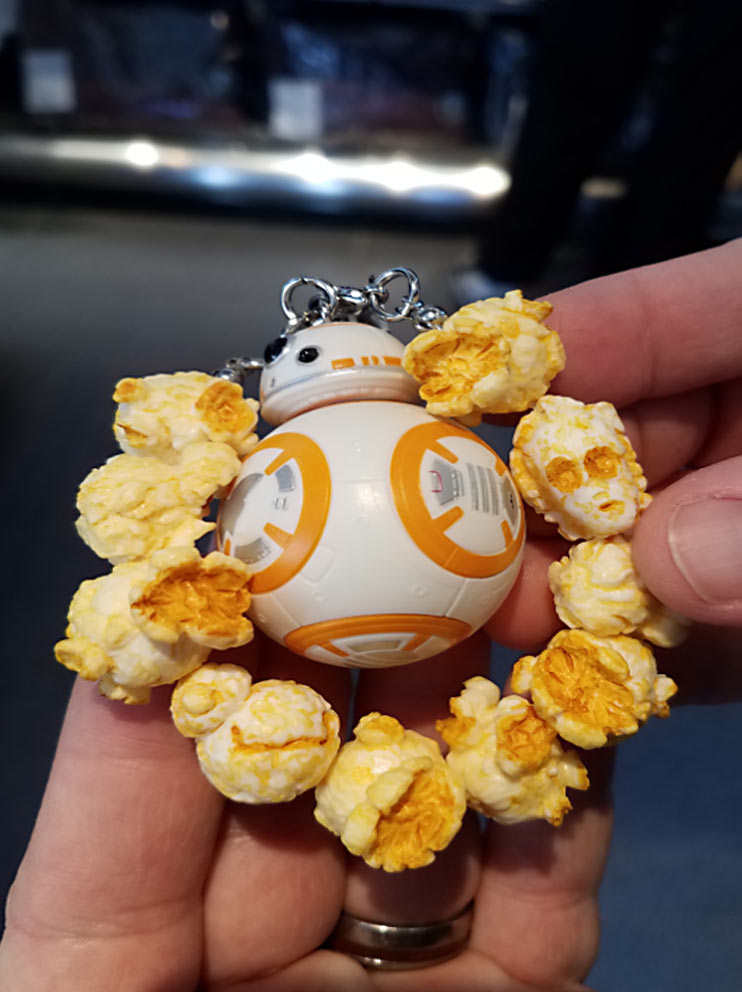
Popcorn is such an important part of the Tokyo Disney experience that you can also buy popcorn-themed souvenirs in the gift shops. Look at these keychains made of rubber pieces of popcorn — and look closely for the hidden Disney characters!

I should mention too that if you purchase large popcorn “feeders” such as these, it’s not a problem to bring them on the rides with you. (In fact, it didn’t seem to be a problem to bring anything at all on a ride in either of the parks — more on that in a moment.) Earlier in the day, before we bought these Star Wars popcorn feeders, we were enjoying a box of popcorn when we walked to the queue to Space Mountain. The attendant motioned to our open popcorn and said “Make box.”
Make box?
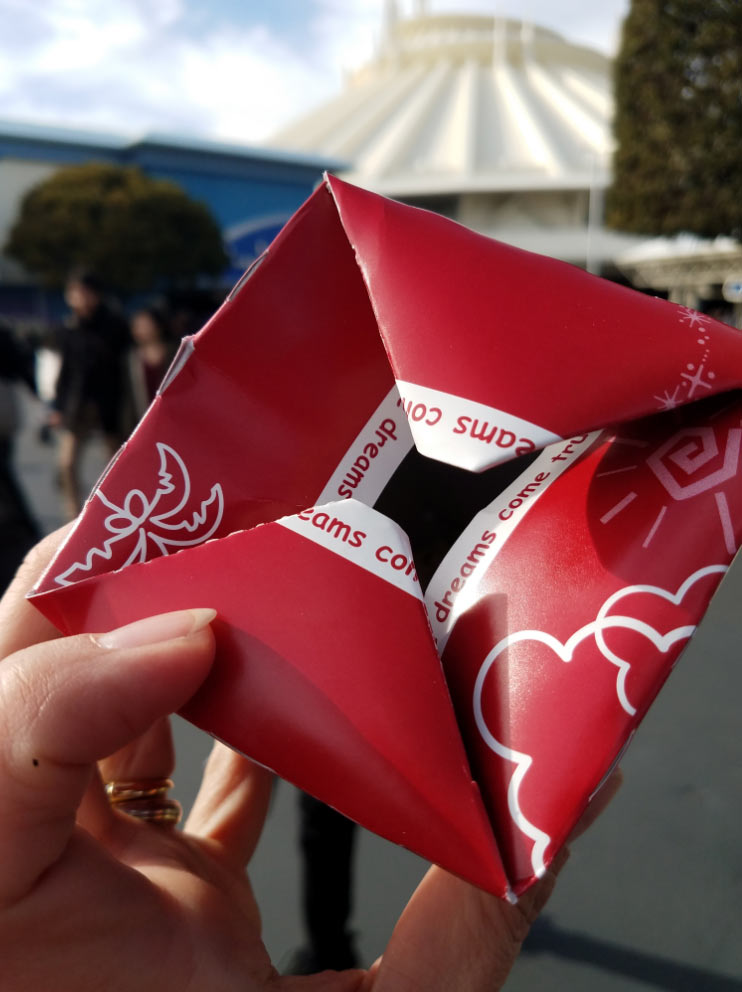
Then we figured it out. The sides of the popcorn box folds into a lidded box that you can close and carry on rides with you. They think of everything here! So, yes, you can take popcorn, or just about anything else on a ride with you if you’d like. In fact, we were encouraged to do so by the park’s cast members.
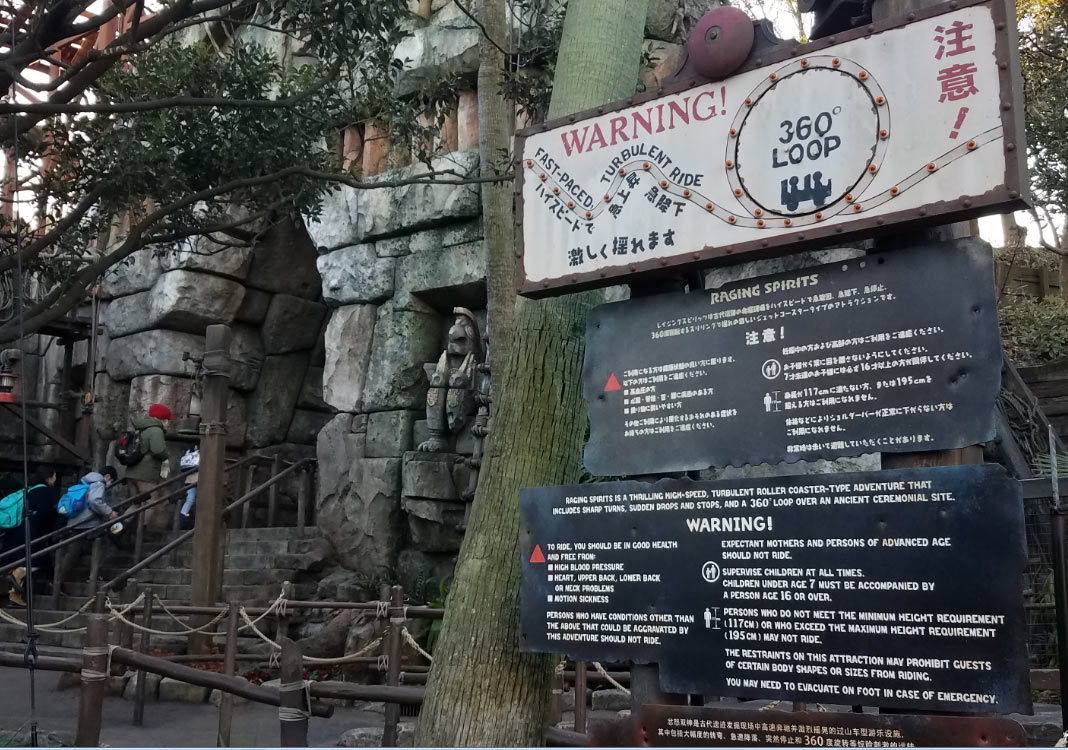
While in line for DisneySea’s Raging Spirits wooden roller coaster, which has one 360-degree inversion and a sign warning that it is a “fast-paced turbulent ride,” I looked around for a locker or cubby to put my now-multiple shopping bags of souvenirs into while we rode.
No lockers.
The ride attendant motioned to my bags and said “Hold on to bags.”
You got it.
I held on. We looped the loop. All souvenirs survived. Could you imagine doing that in America?
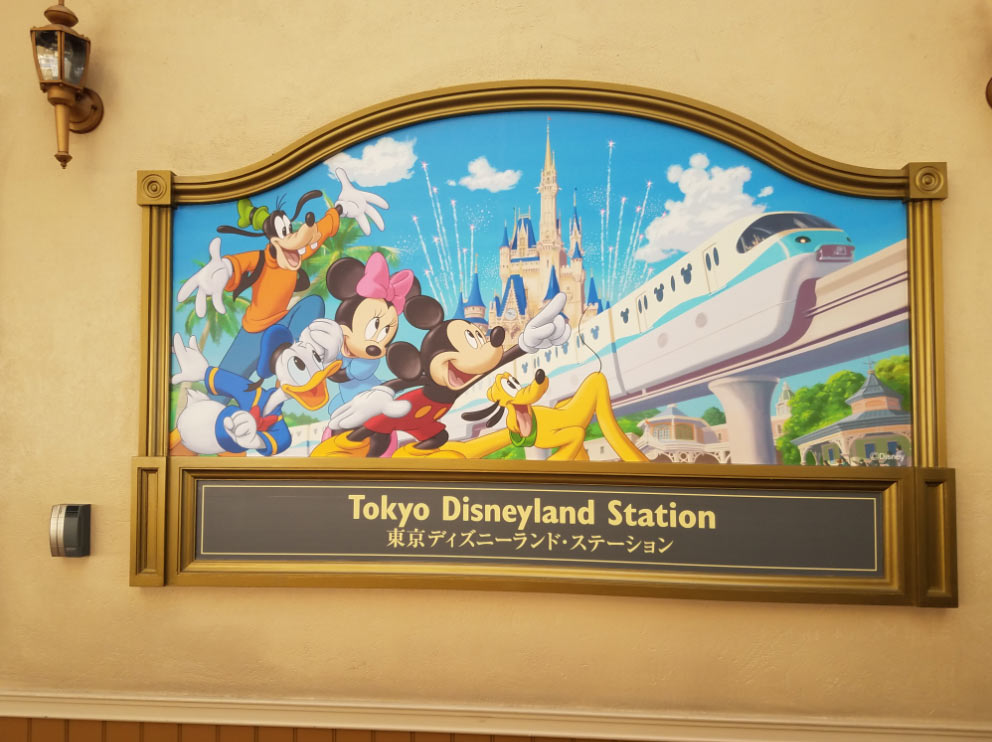
“Language barrier?” What language barrier?
We arrived in Japan speaking no Japanese other than “arigato” and “irasshaimase.” Over the course of the ten-day trip, everyone in the family picked up a few more words and phrases, but Japan is surprisingly easy to navigate as English speakers. Nearly all signage in airports, train stations, stores, and restaurants are presented both in Japanese and English, and we found this was true in the Tokyo Disney parks as well. The language “barrier” is nearly nonexistent.
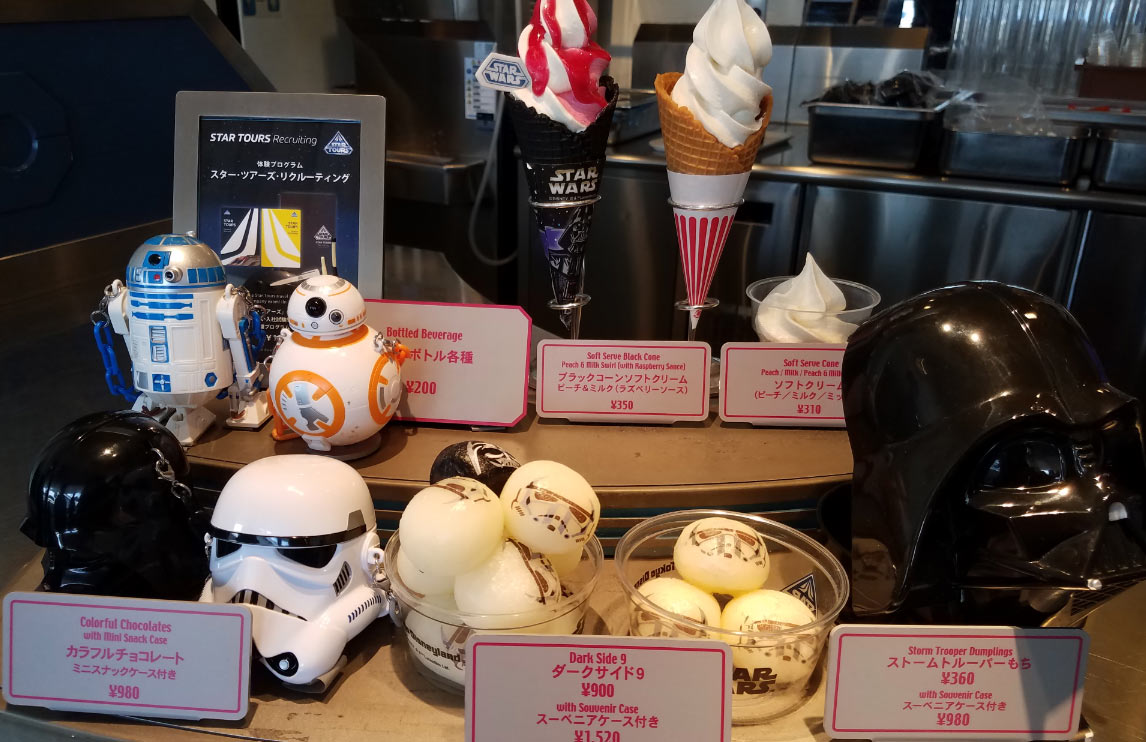
Disney signage, park maps, and menus are in both English and Japanese. Some of the ride’s soundtracks and voice-overs are solely in Japanese, but we got such a kick out of riding Star Tours and other attractions with Japanese audio tracks! It’s all part of the experience.
Most of the cast members speak at least some English, and many are fluent. We never really had a communication issue in the parks.

Souvenir shopping is memorable… and interesting!
The souvenirs you’ll find in the gift shops at the Tokyo Disney parks are really interesting. You’ll see Japanese-themed plushes of the classic Disney characters, which you might expect. You’ll also see many plush toys of Duffy, Mickey’s American teddy bear and Duffy’s friends — characters that aren’t nearly as known in the United States as they are in Japan. Duffy is simply a wildly-popular Disney character here. In fact, the American Waterfront area of DisneySea has multiple photostops for guests to position their Duffy bears among flowers or scenic backdrops to photograph them! You can also purchase numerous outfits and clothing items for the Duffy bears in the gift shops.
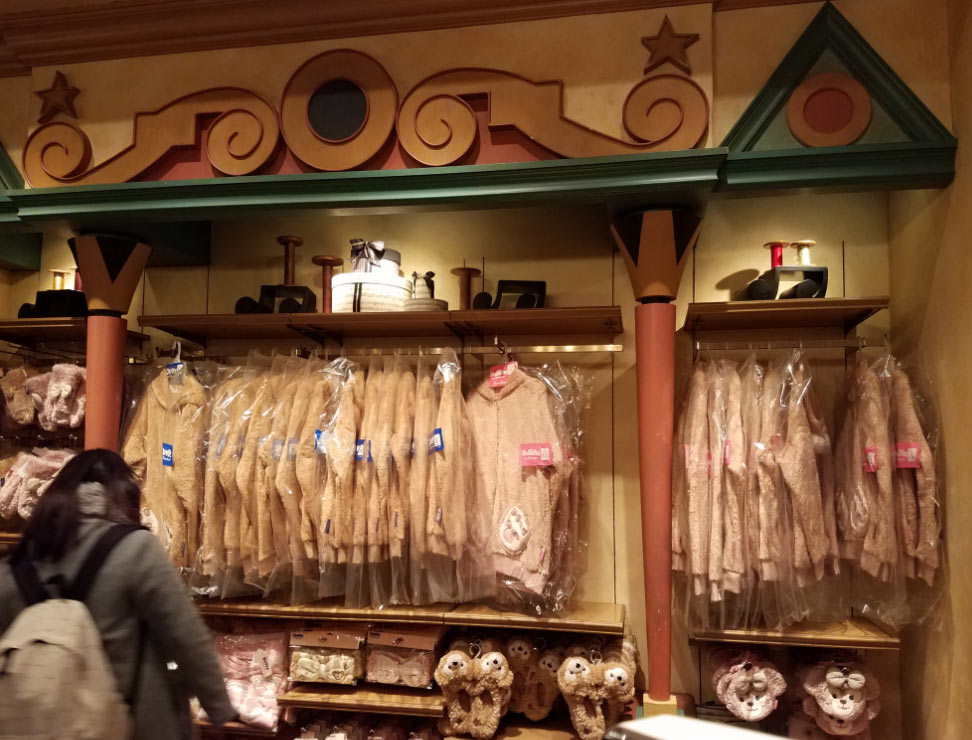
We saw many, many Japanese park guests carrying plush Duffy bears and taking photographs of the bears, and most of these guests were not children. It touches back on what I noted before, that these parks have an escapism element for the adult Japanese audience that involves dressing in bright, often visually loud character gear, carrying toys around the parks, and exploring the child in themselves — it’s all a normal part of the Tokyo parks’ ambiance. You can even buy adult-sized faux-fur covered Duffy hoodies with bear ears on the hoods and paws over the hands — for both men and women! And yes, we saw many adults wearing these too.
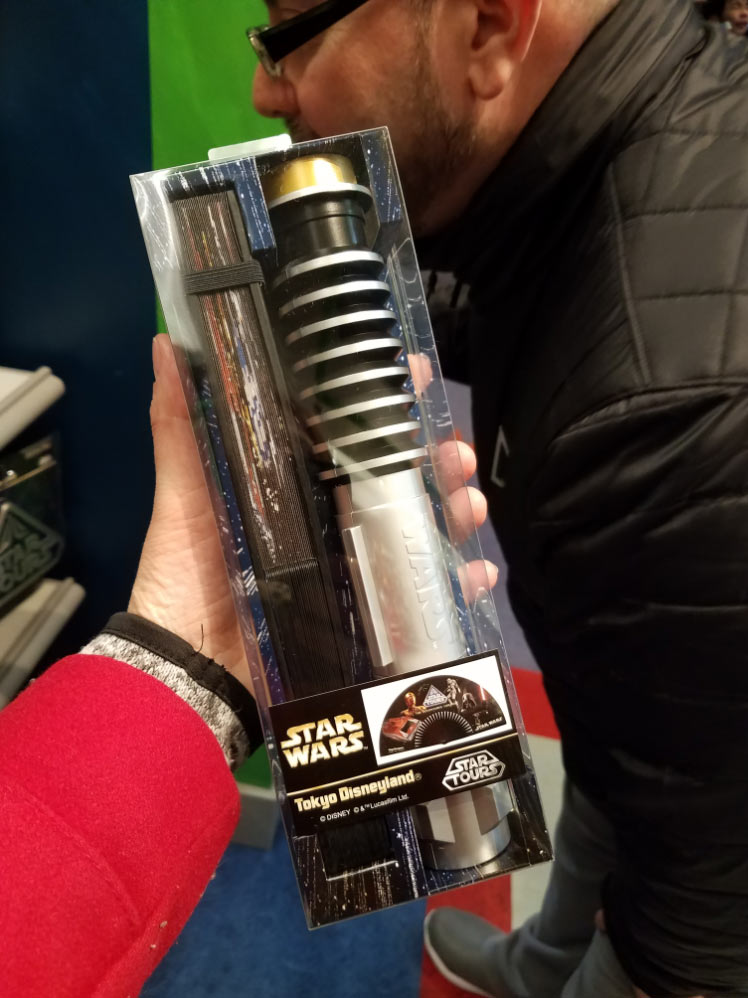
Other souvenir items are completely unique to Tokyo. We bought this Star Tours Lightsaber handle that holds a Japanese fan printed with Star Wars characters. Only in Japan!
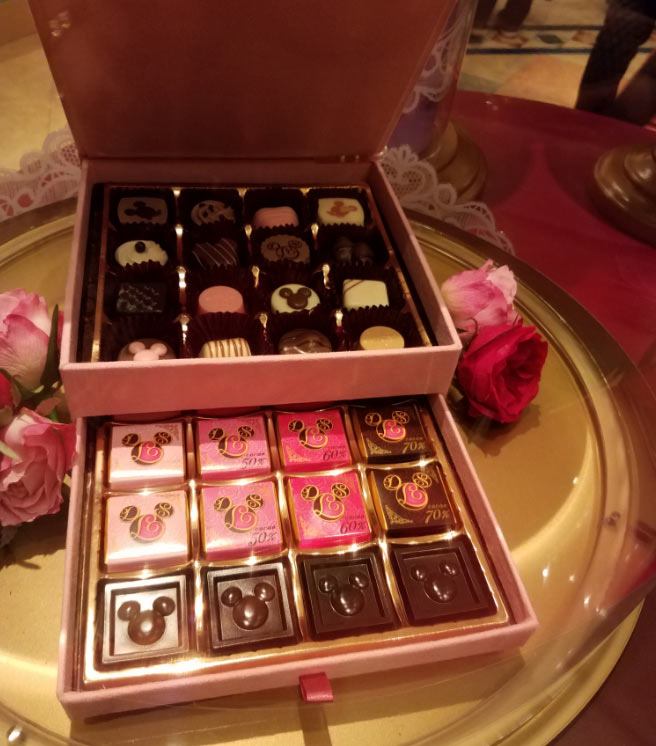
There are numerous chocolate, cookie, and wafer gift boxes for sale. Tokyo Disney has its own chocolatier called Disney Sweet Love, and their creations were so beautifully detailed. (And delicious!)
While the gift shops have a multitude of clothing items featuring the Disney characters, it’s nearly impossible to find any clothing with the names of the parks printed on them! We each wanted to get a shirt to commemorate our trip to the Tokyo Disney parks, but this was much more difficult than you might think.
Apparently it is not part of the Japanese culture to show off the places you’ve been (at all) so it is very difficult to find clothing items that say “Tokyo Disneyland” or “Tokyo DisneySea” on them. Again, 92% of the visitors to these parks live in Japan, and less than 1% of visitors each year are American, so from a financial standpoint, it probably doesn’t make sense to create merchandise that doesn’t appeal to the majority of guests.
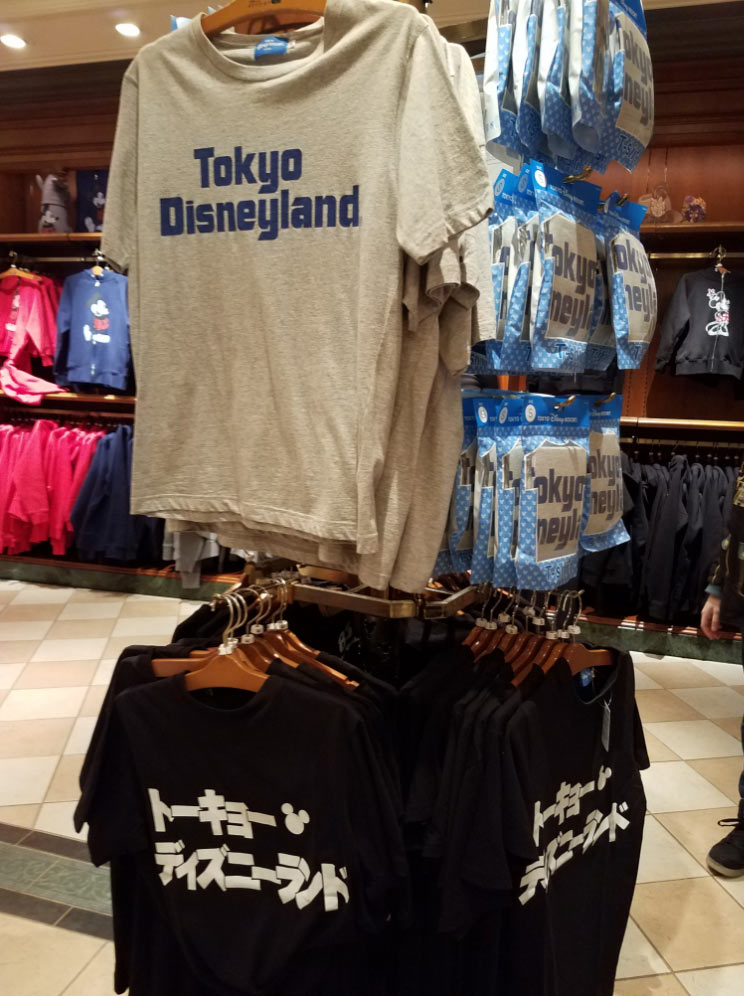
After asking for help, I was directed to go to one specific gift shop in Disneyland which carried a scant selection of what the cast member assisting me referred to as “foreigner shirts!” These shirts are very basic in design — no characters, castle, or graphics — just the logo of “Tokyo Disneyland” with nothing on the back of the shirt. Or, you can choose the Japanese version which contains a cute Mickey head icon on the front and the year that the park opened printed on the back.

If you want a DisneySea shirt, you have your choice of these two styles — and only these two styles — one in Japanese, and one in English. Of course, we bought all four of these shirts, because we are Americans who like these kinds of things! Prices were very reasonable — about $15 USD for the Japanese logo shirts and $13 for the English ones.
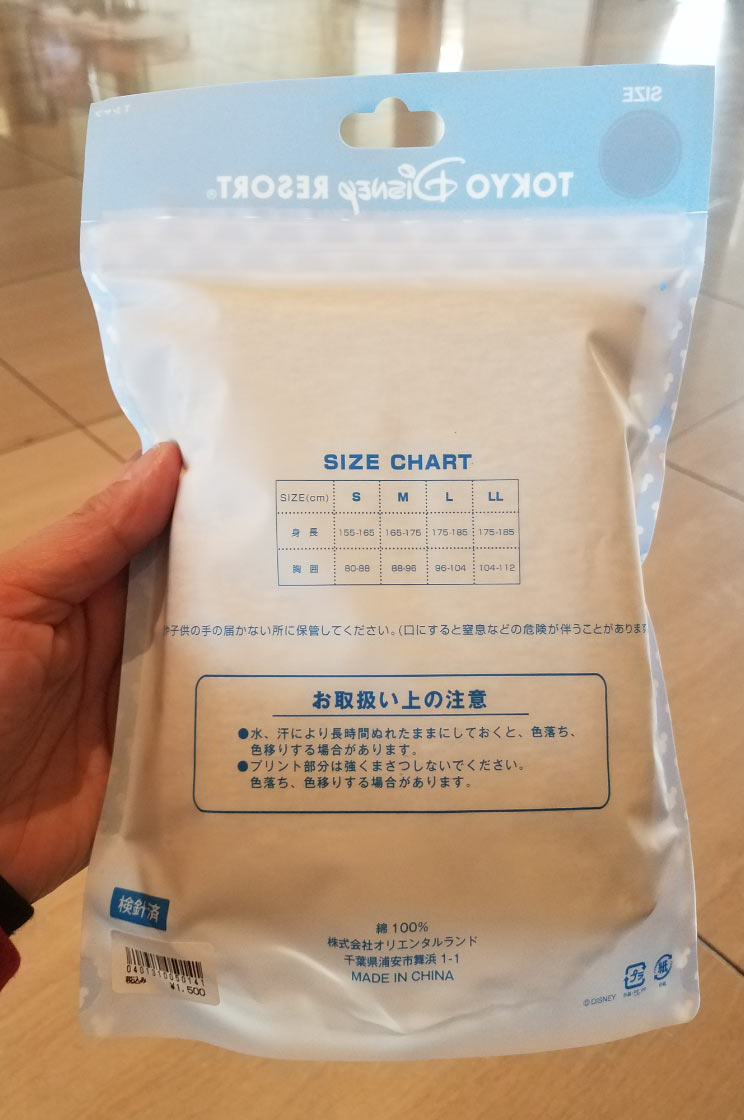
Unfortunately, only three Cataldos brought T-shirts home, because the available sizes are very small. The sizes range from S to LL, with the LL being a Long Large, which is about the size of a men’s Medium in the USA. They’re still some of our favorite souvenirs of the trip!

Dining in the parks is amazing — and often a bargain.
We love dining at Disney, but there’s no denying that food can be pricey in the US parks. So, we were extremely surprised how reasonable the food was in the Tokyo parks! Everything we ate was delicious, and it was often fun to eat too, like this steamed pork bun in the shape of Mickey’s gloves.
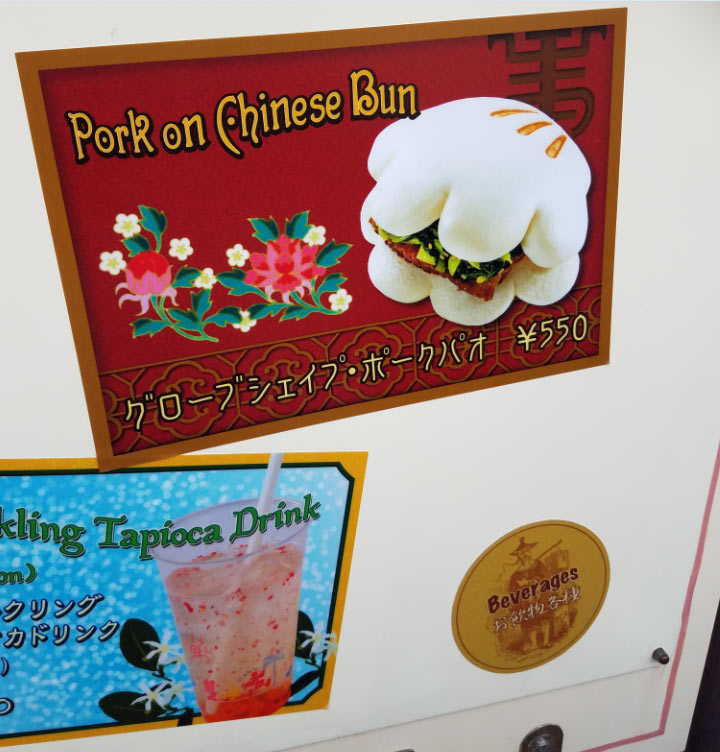
The easiest way to convert yen to US dollars is to look at the price of the item, then move an imaginary decimal point two places to the left. This pork bun’s price is ¥550. We’d look at it and say, “That’s about $5.50.”
In reality, it’s a little less than that — with the currency conversion rate at the time of our trip, it was actually $4.85! But, we found that this was a fast and easy way to estimate the price of something when we were out shopping or dining. Our kids very quickly picked up on this method and kept their own souvenir shopping in budget too throughout the trip.
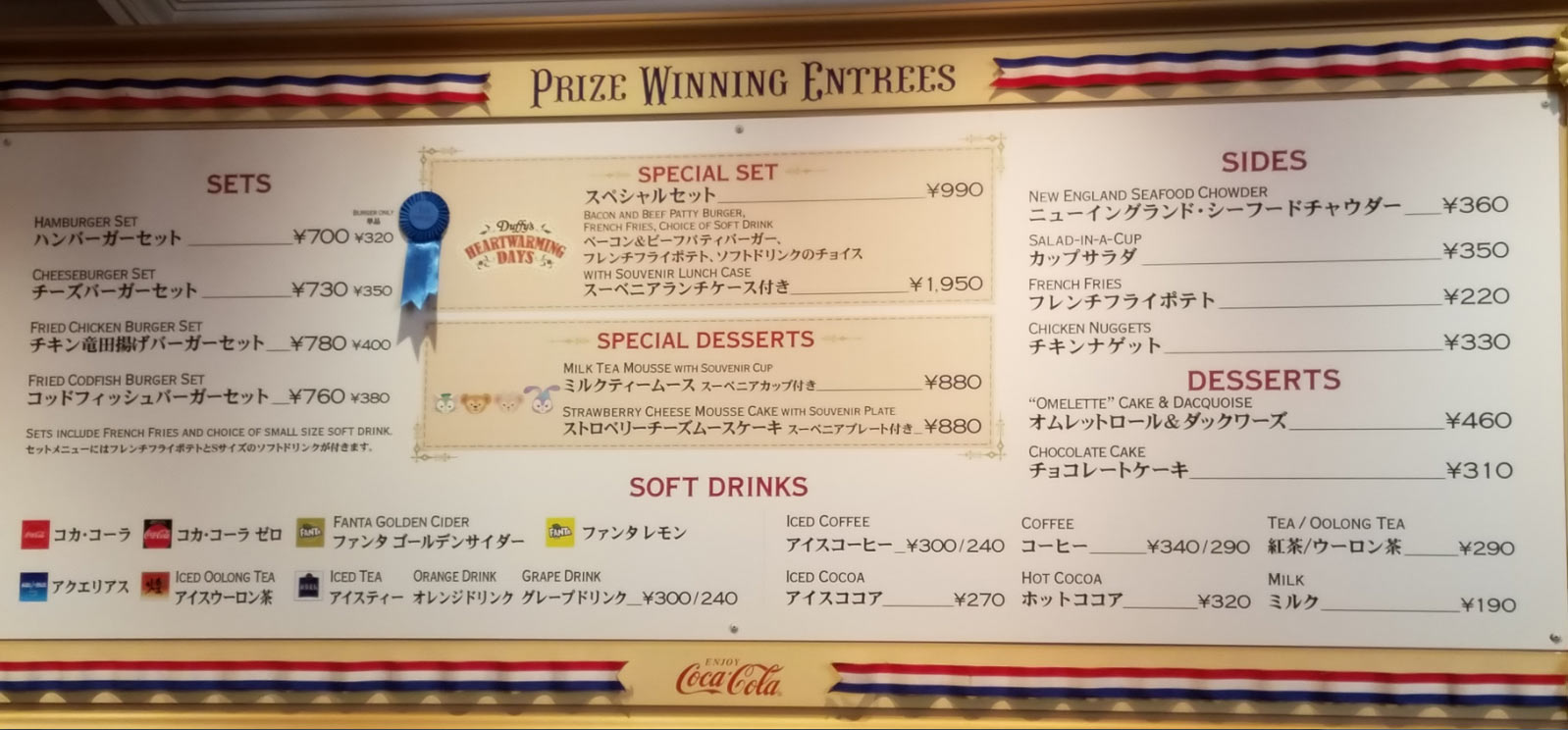
Now, take a look at this menu from the counter-service restaurant at DisneySea’s American Waterfront. You can buy a “hamburger set,” which is a burger, fries, and soft drink, for ¥700 — we estimated $7.00! ($6.20 actual.) A cup of seafood chowder is ¥360 — we estimated $3.60. ($3.19 actual.)
It was quite a surprising difference from what we’ve paid in the past in Florida and California, where a similar meal “set” would run $15.00 per person or more. This brings me to this next eye-opening statement that you may not expect to be true — but we found to be true:
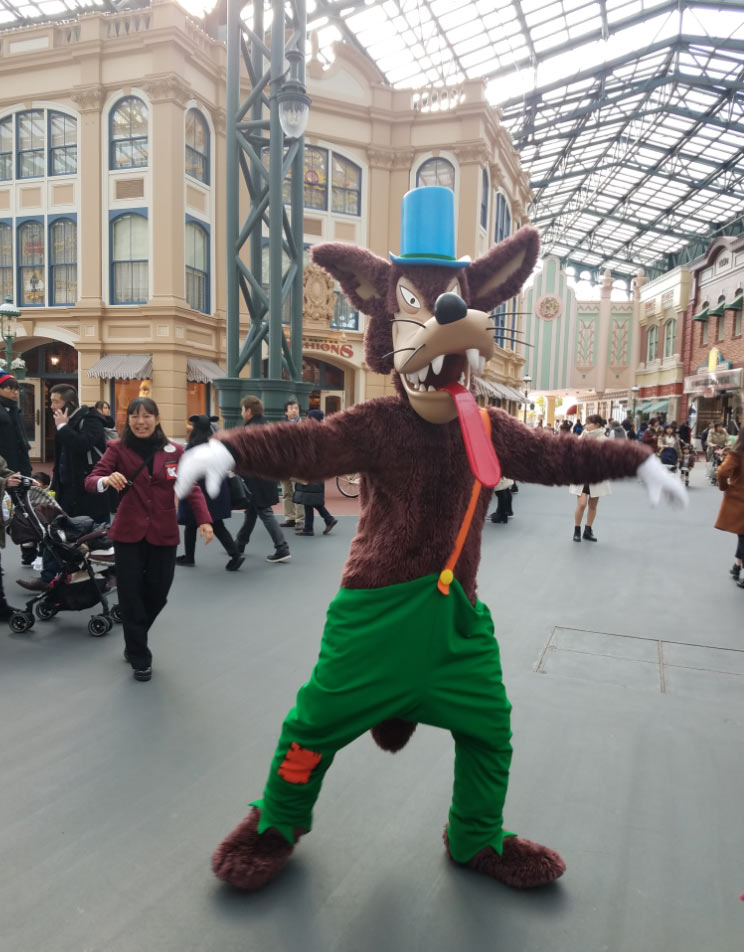
Visiting the Tokyo Disney parks is not as expensive as you may think. In fact, it may cost less than a trip to Walt Disney World!
It’s much less expensive to walk through the gates of Tokyo Disneyland and Tokyo DisneySea than it is to enter Walt Disney World. Really. If you’re one of my regular readers, you know how budget-minded our family is, and this trip was certainly done on a budget. What a grand, incredible trip we had though!
The biggest hurdle, of course, is airfare. If you pick any random date and look at airfare from Chicago to Tokyo, you’ll immediately be greeted with airfares in the $1200-$1500 per person range. (Ouch.) However, if you want to do this trip for a fraction of that, you’ll need to be flexible. We knew what time of year we wanted to go, but our entire ten-day trip to Japan was planned just four weeks out. As soon as the airfares dropped, we booked, then started planning out each days’ destinations and making hotel reservations. Airfares can be surprisingly reasonable if you jump on them when they take a dip.
I recommend subscribing to an airfare watch service (I like Airfare Watchdog, but there are many others out there.) With this, you can enter your home airport and any other airports around the world that you wish to watch, along with the threshold you wish to pay for airline tickets. I entered Chicago, Tokyo, and Osaka, and I set our maximum spend threshold for fare alerts at $600 per person. Airfare Watchdog sends alerts every single week in this price range. Here’s a sampling of the deals I’ve received from them just over the past few weeks:
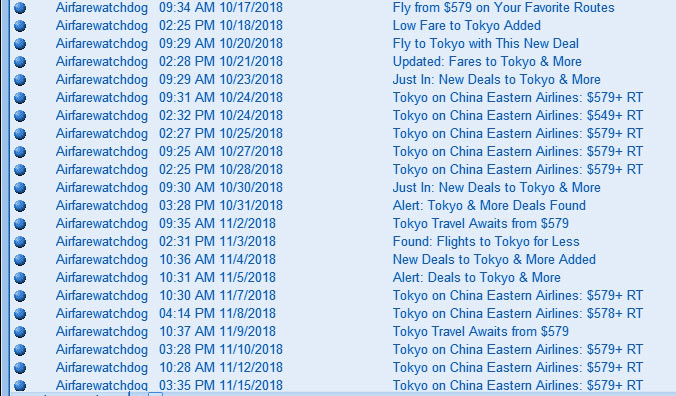
Again, this is very important — you will save thousands of dollars per ticket if you book when a deal drops versus plugging dates into a traditional travel or airline’s site. We paid about a third of what it would have cost to book the trip on the specific day we initially set as our “want to leave” date. You can easily find fares in this price range every week. Sometimes they’re even better — we saw a fare for $420 round trip to Tokyo in August!
Where to stay? There are four official Disney-branded resorts (Ambassador, MiraCosta, Disneyland Hotel, and Celebration) as well as a couple more major-name hotels along the monorail line that are also considered official Disney resorts.
We stayed at the Tokyo Bay Hilton. Our friends had previously stayed there and enjoyed it, and you can also use Hilton Hhonors points toward the room’s cost. I’ve written at great length in some of my other travel posts about how much we enjoy using our Hilton points for free or discounted room stays (and other perks like free breakfasts!) and this trip was no exception.
The hotel has both contemporary-designed modern floors and “Happy Magic” floors decorated in a family-friendly enchanted forest theme. You can see where we stayed! This room sleeps up to five and has a king bed, a twin bed, and two twin bunk beds. It also has a magic mirror on the wall that showed a child’s face speaking Japanese and other magical things that turned on and lit up when our children turned a special key in the wall! Really cute.
We thoroughly enjoyed staying at the Tokyo Bay Hilton as it was right in the middle of the Disney magic, and the parks were a quick monorail or bus ride away.
Ready for a ticket price comparison? Assuming you will want to spend at least two days in the Tokyo Disney parks, let’s look at park ticket pricing.
At Tokyo, a 2 Day Passport ticket is currently:
- ¥13200 for adults ($116.98 USD – $58.49 per day)
- ¥11600 for juniors 12-17 years ($102.80 USD – $51.40 per day)
- ¥8600 for children 11-younger ($76.22 USD – $38.11 per day)
In contrast, a 2-day Walt Disney World park pass prices now vary by start date, but a two-day pass with a Nov. 18th start date is $237.36 for ages 10 and up — that’s $118.68 per day.
Obviously, there are four major parks to choose from in Walt Disney World instead of the two at Tokyo Disney Resort, and pass prices at both WDW and TDR do continue to drop according to the number of days you purchase at a time. I love all of the Disney parks we’ve visited, and this discussion of pass pricing isn’t meant as a negative for WDW, as WDW is an enormous resort unlike any other with an incredible selection of attractions and experiences. I’m presenting this more as an eye-opener for how affordable a Tokyo Disney trip can actually be!
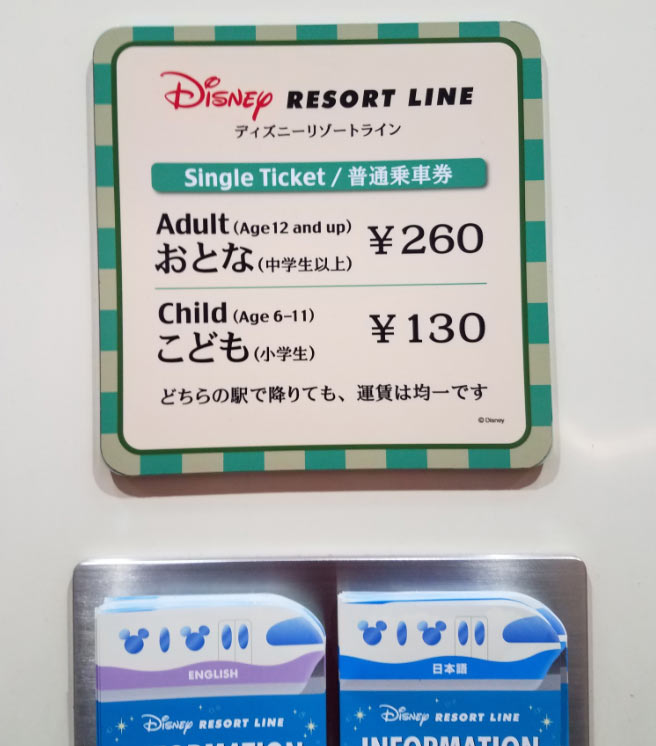
But… you’ll pay to ride the monorail!
It’s true! Anyone used to zipping around free of charge on the Walt Disney World Monorail system will likely be a little surprised to see that you need a ticket to ride the Monorail in Tokyo. There’s a reason for this: The Japanese government requires any rail line that connects to the public rail transit system to charge a fare. Tokyo Disney’s monorail actually runs to the Maihama public train station, so it is considered a public train.
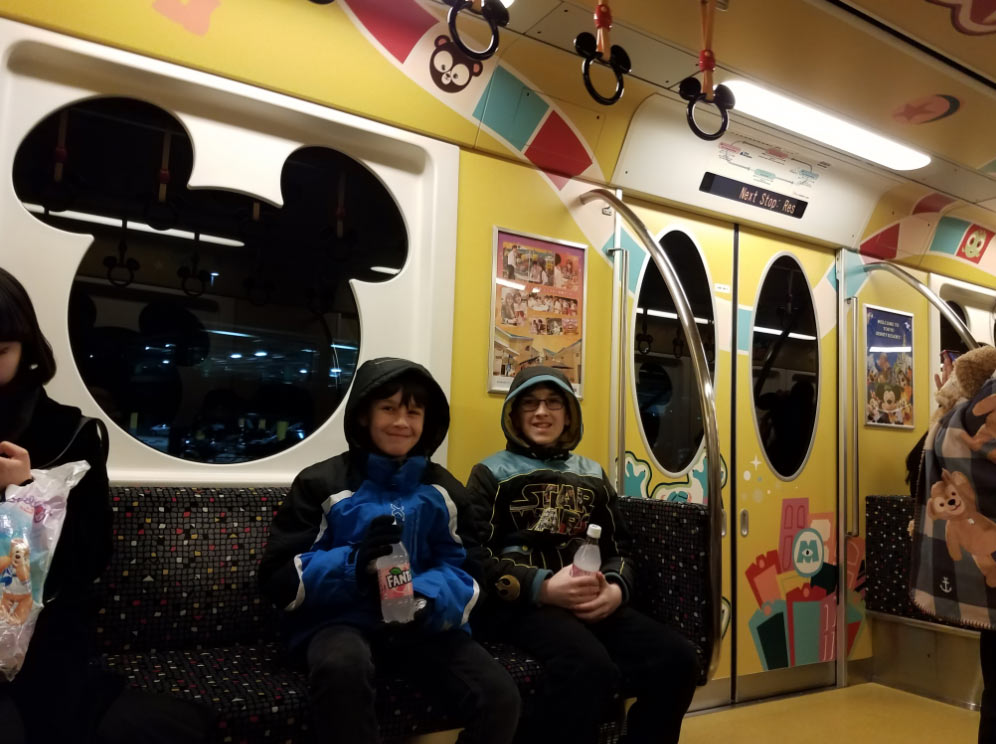
However, the monorail fees are extremely reasonable – ¥260 for adults and ¥130 for kids ($2.30 and $1.15, respectively.) And, when the train cars are this cute inside, who’s complaining? The Tokyo monorails are actually re-designed and re-themed inside multiple times each year to match events and promotions going on in the parks. This train’s theme is “Pixar Playtime.”
Last thoughts…
We WILL be returning to Tokyo Disney Resort! We had the most amazing time, but as is true with any Disney park, two days simply wasn’t enough to see everything that these incredible and highly-immersive parks had to offer. We visited the parks on the last two days of our ten-day Japan trip, and we intentionally split our trip into staying in different cities and different areas of the country prior to going to Disney. We absolutely love Japan — our oldest son already announced during the trip that he wants to move there! — and now that we’re familiar with navigating around Japan, we’ll plan another visit hopefully within the next couple of years.
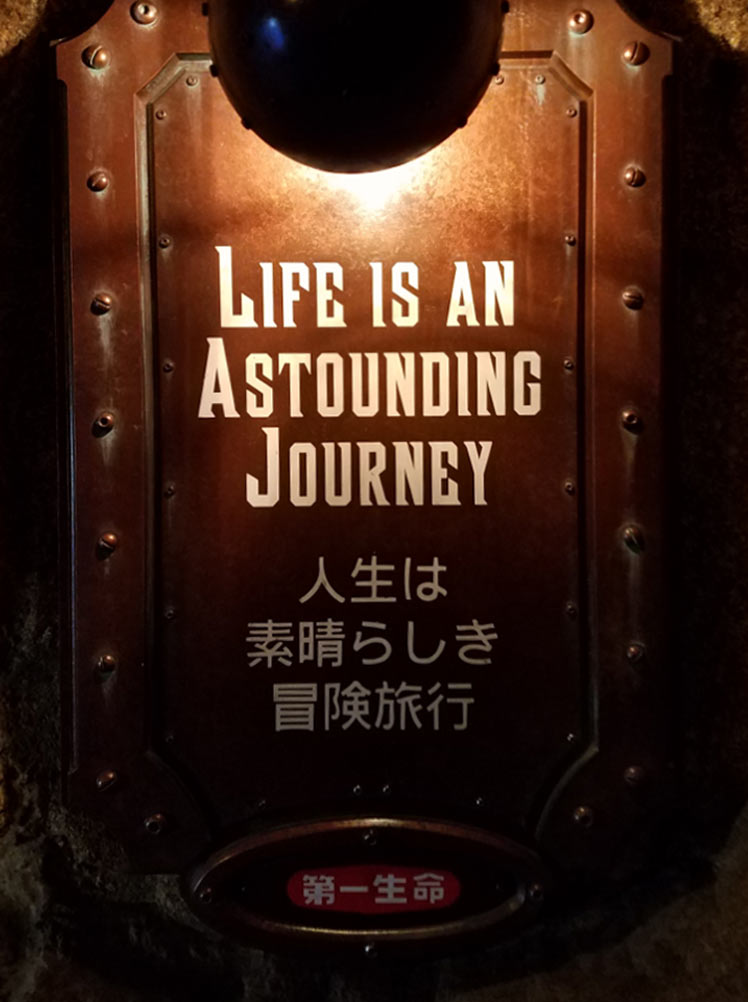
I’ll leave you with a few more random observances and thoughts about Tokyo Disney Resort:
- Fastpasses for rides within the park are the “old style” paper tickets that are still in place at Disneyland and Disney’s California Adventure parks. You cannot and do not need to reserve Fastpasses online before visiting the Tokyo parks. Simply visit the Fastpass kiosks, scan your Passport (park ticket) and grab Fastpasses for the next ride. We were able to ride all of the major rides at DisneySea with this method, with the exception of the Aquatopia boats, which were closed for refurbishment on our visit.
- Tokyo Disney’s official wait time app is only in Japanese. However, there’s a fan app called TDR Dash that translates the Tokyo parks’ attractions wait times into English. Its interface is rather bright and colorful, but the wait times were always accurate, and it helped us fit in even more attractions. Any time we’d see something with a five or ten-minute wait, we’d run over and get in line.
- While every Disney park I’ve visited is exceptionally clean, the Tokyo Disney parks are clean on an entirely different level. They are immaculate. There is no dirt on the ground — anywhere. No gum, no bird droppings, no trash. You never see dirty handprints, or worn paint, or anything like that anywhere. The parks are pristine in a way that is almost surreal, and it’s due not only to the parks’ own efforts but to the culture of the Japanese people. If the wind blew a food wrapper or a straw off a table, a guest immediately picked it up. No one litters. No one vandalizes.
- During the trip planning process, it occurred to me that had we really wanted to go Disney-crazy, we could have visited two more Disney parks on this trip! We flew from Chicago to Shanghai, and while we had a stopover, we hadn’t scheduled enough time to stay in China and make it to the Shanghai Disney Resort before continuing on to Osaka. (Maybe next time!) Conversely, when we flew back to the USA from Tokyo, we had a few hours’ layover at LAX. We could have extended that and gone to Disneyland too!
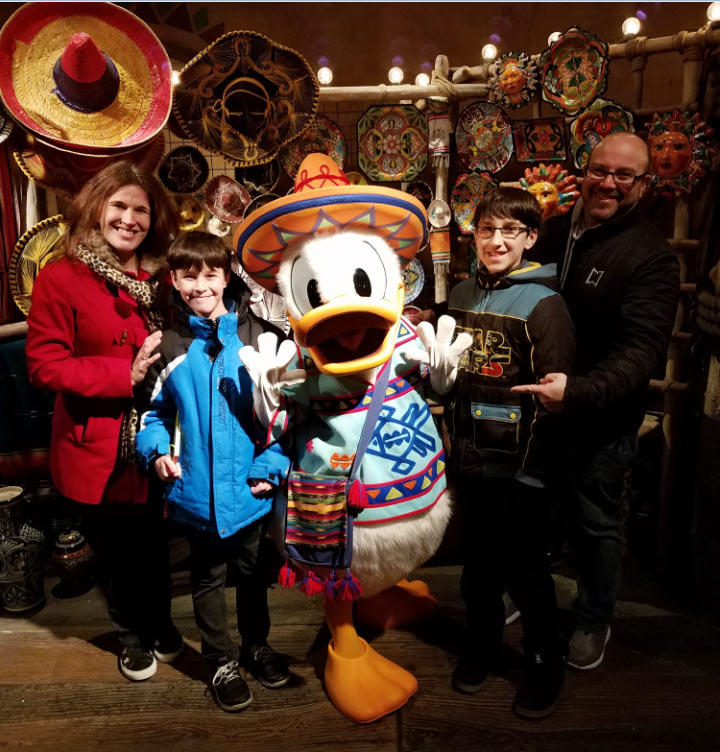
(We went all the way to Tokyo to visit Donald Duck in “Mexico!”)








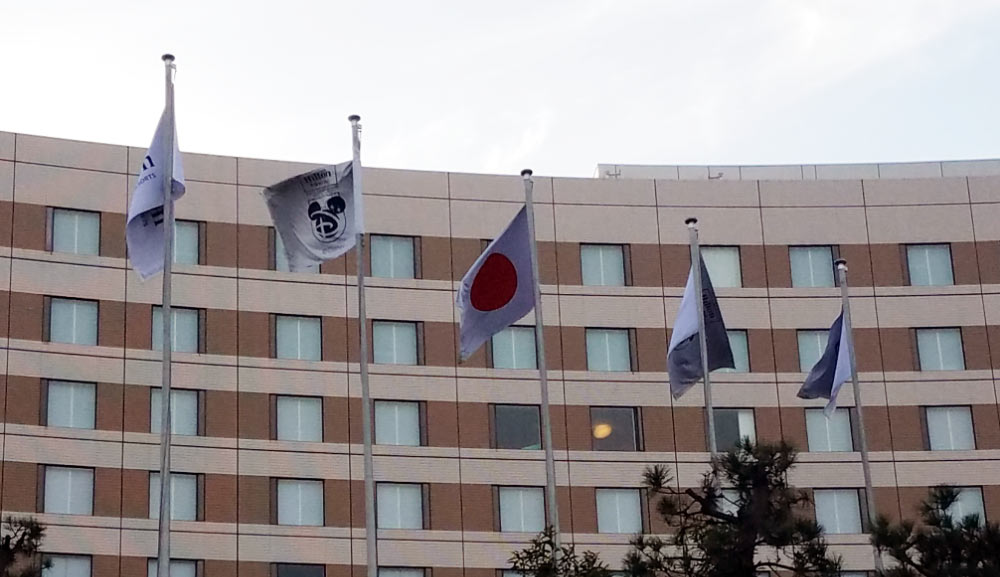
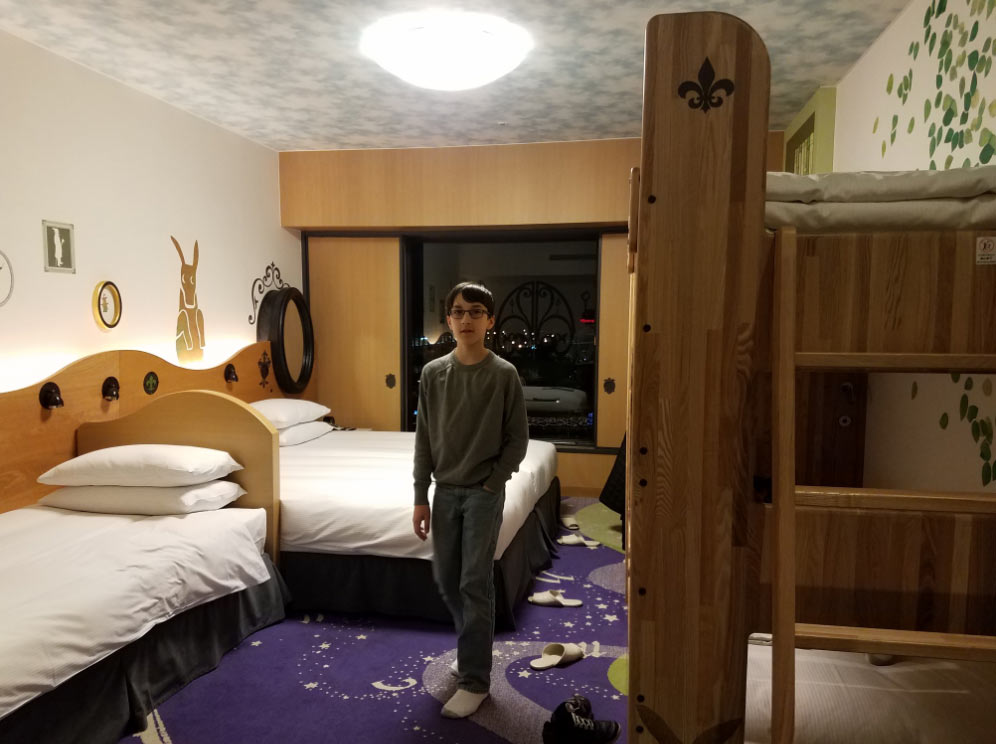

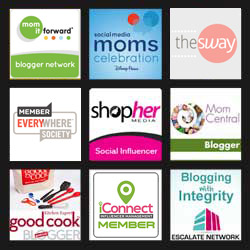
Michael says
Wow you mad it to the holy grail of Disney parks! Really well written and so much info to absorb. You answered every question I already thought of about getting around without knowing Japanese. Laughed out loud when I read you trying to find T shirts! Come on it wouldn’t take much more ink for them to print the Fab 5 on there and make us Americans happy!
Can you tell me how much that Hilton on the monorail is per night if you don’t pay with points? Are there other American/national chain hotels on the monorail?
Tokyo Disney is a bucket list trip for us too. Great to see what real airfares are out there as it brings it a lot more in reach for us. We want to wait til the Olympics are over so it won’t be so crowded.
Also how long was the flight?
Coupon Maven says
That Hilton seems to run $180-$250 a night outside of holidays or other super-busy times. There’s also a Sheraton near the Hilton, and several other large Japanese hotels. Here’s a full list:
https://www.tokyodisneyresort.jp/en/hotel/
The Disney Celebration hotel, while one of the official hotels, is a value resort and is actually further away from the parks than some of the big-chain hotels — that hotel is about 20 minutes away and has a bus instead of monorail access.
As for flying… this was the longest flight we’ve ever taken. It took us around 17 hours to get there. There -are- non-stop flights that can do it in 13-14 hours, but they’re pricey, and you’ll find better deals if you allow one stopover. We flew about 15 hours to Shanghai, had an hour layover, and then flew into Osaka, which is about another 2 hours. Coming home, we flew from Tokyo Haneda to LAX, about 10 hours, and then another 4 hours to home.
It was our first time flying on the Dreamliner too, which was a lot of fun. The plane is HUGE and has electronically tinted windows that darken the cabin to help you get acclimated to what time it will be when you arrive in Asia. We flew American for three out of the four legs, so everyone had seatback movies and entertainment the whole time. From Shanghai to Osaka, we flew Japan Airlines, and we absolutely would fly them again too — immaculate planes, seat-back video games, and a two-course Japanese meal served in flight to everyone, including coach!
Meagan says
I am totally blown away by those food prices and ticket prices. I always assumed the that all the parks were super expensive. I just added this to our list of things to do this summer! So happy I found this post!
Coupon Maven says
Meagan, we assumed that too about the prices — I guess, how would you know otherwise unless you go, or seriously research going? We will definitely, definitely go back. The park is undergoing large expansions too, so we can’t wait to see what’s new next time :)
RachAel says
We have a goal to visit all the Disney parks but thought the Asian parks would be intimidating so we saved those last for our bucket list. This makes it seem like it would not be difficult at all. So surprised at the prices (pleasantly.)
Coupon Maven says
I’d love to visit them all someday as well. Tokyo Disneyland and DisneySea completely stole our hearts, and we will definitely go back! The Disney Parks blog is a great place to follow along with what’s going on and new in all the parks. We would like to go back when the new Beauty And the Beast land opens in DisneySea in 2020, as well as a new Baymax ride! There is a Japan-themed Soarin’ going in too, and they’re building an official Toy Story hotel! So, we’re tentatively looking at 2020 or 2021.
2022 brings even more attractions and ports to DisneySea, but I don’t know if my family can wait that long :)
Bri says
Hi I love you explanation about everything you did it’s amazing. I’ve been to japan before and I’m also a huge Disney person but I have never been to the parks in japan… I’m going this March and I’m super exited, the only problem or question I have is if you can do both parks in the same day? Just like in Disneyland and California adventure where you have the the Day hopper ticket. Thank you so much 😊
Coupon Maven says
Hi Bri! The passes are a little different at the Tokyo parks. In order to visit both parks in the same day, you will have to get a 3-day ticket. The first two days of this “hopper” are limited to just ONE park. The third day is the hop day. So, you could do Tokyo Disneyland on Day 1, Tokyo DisneySea on Day 2, and on the third day, after doing both single days at each park, you can hop between the two.
We only spent two days there, so we bought a two-day ticket, and there aren’t any hopping options until you get to the 3-day passes and up.
Thank you for your comments – we LOVED the Tokyo parks, particularly DisneySea, and we can’t wait to go back!